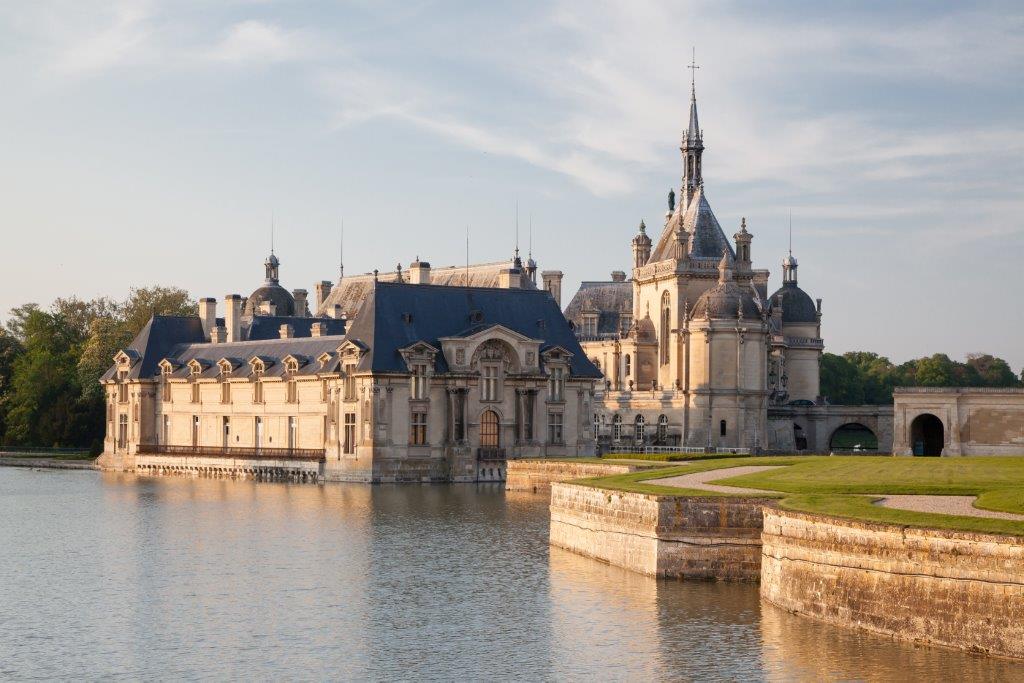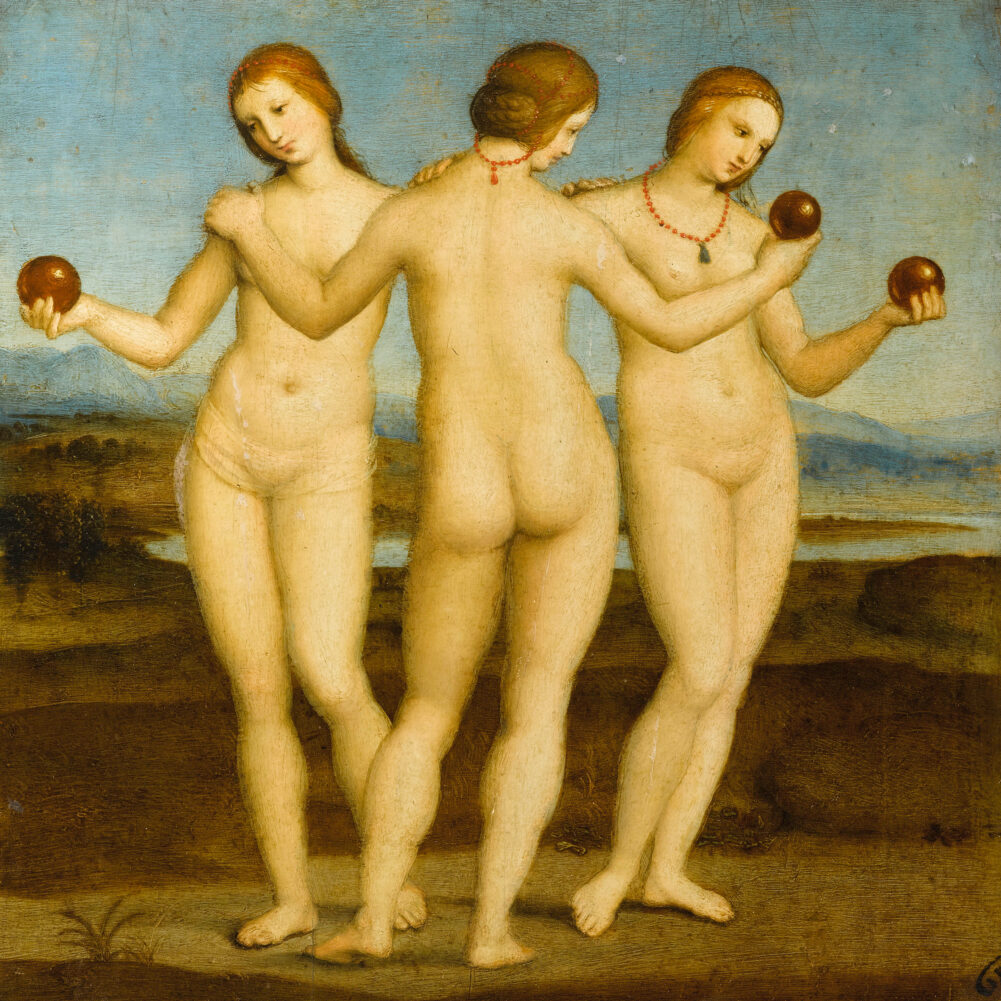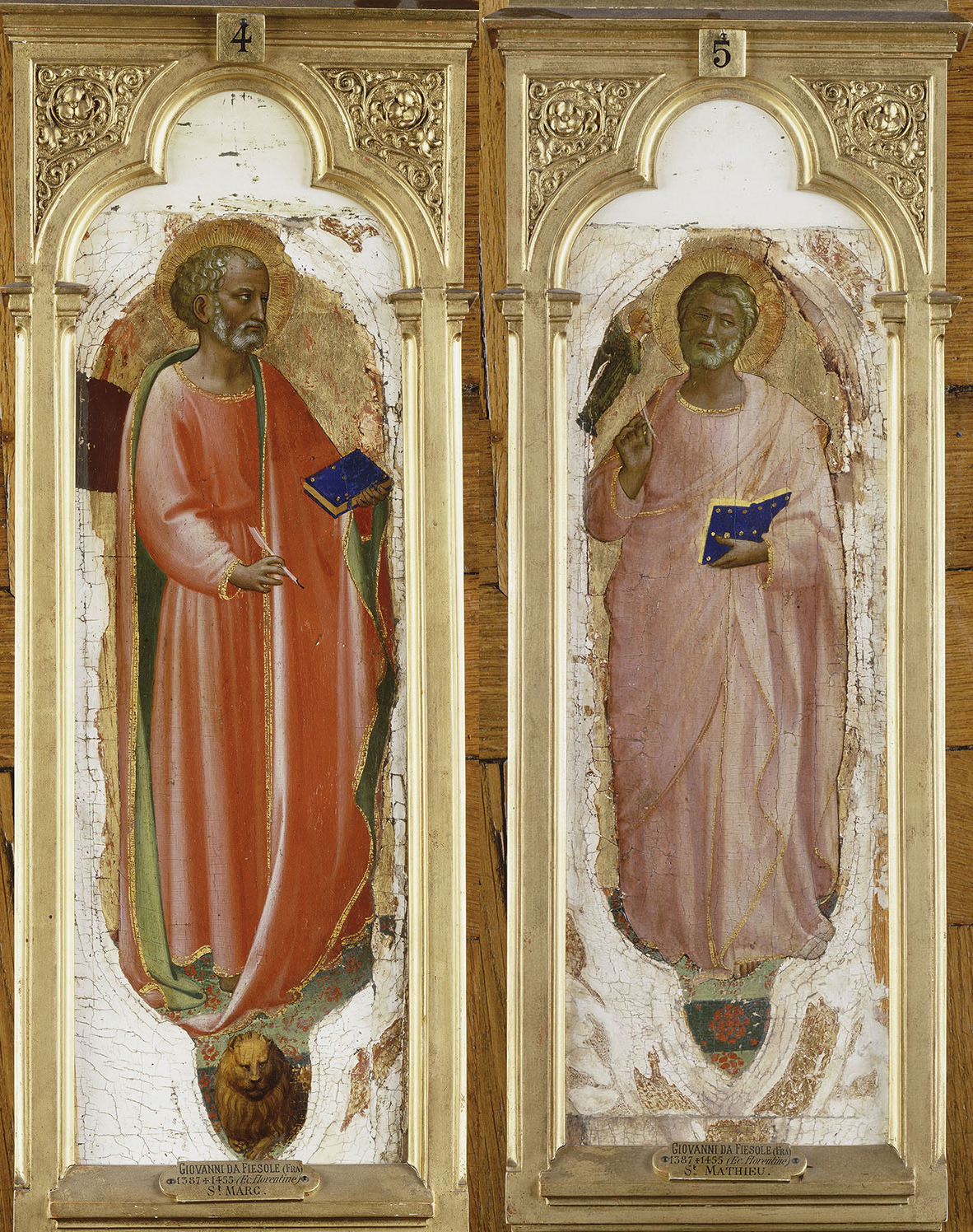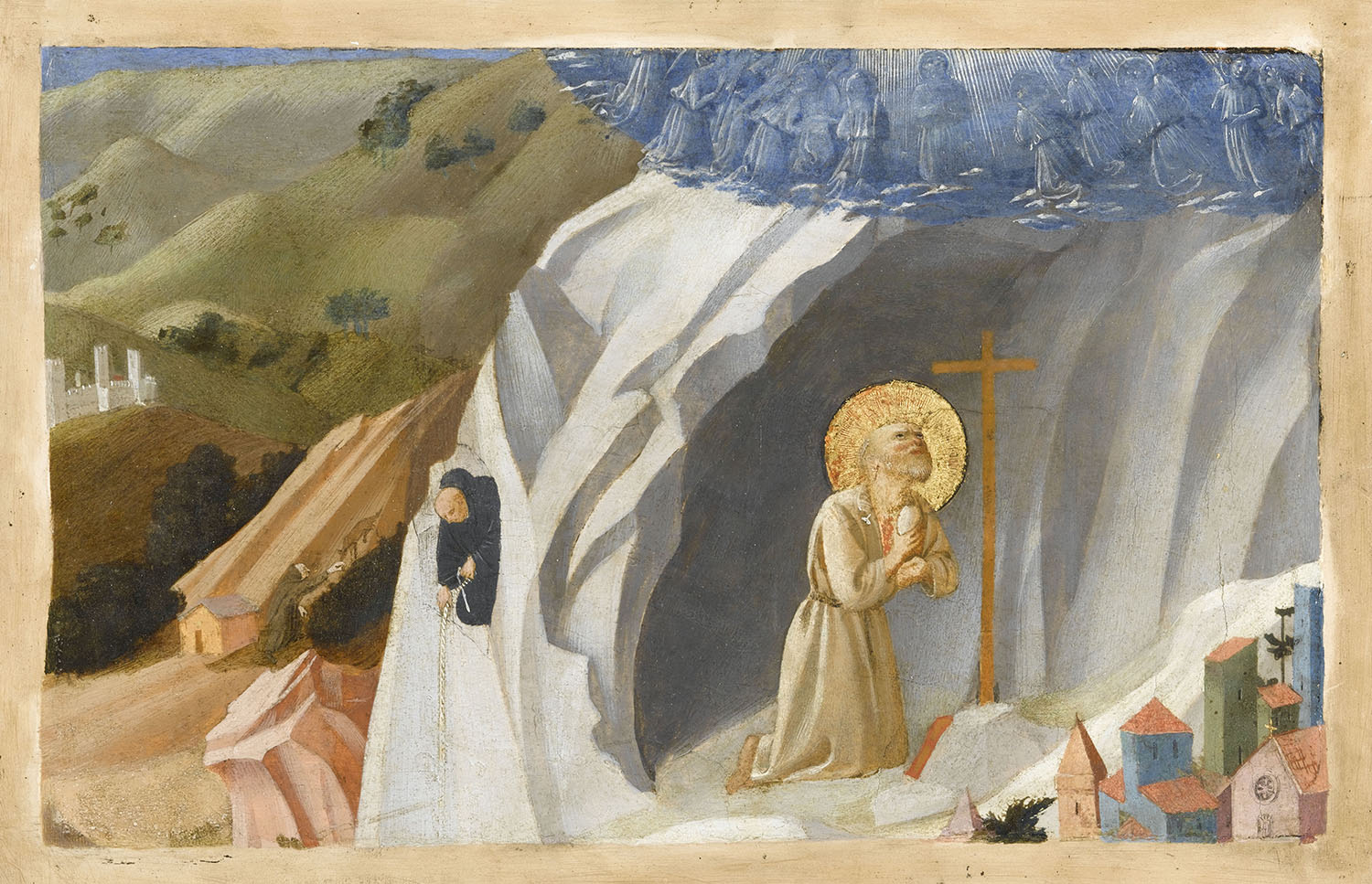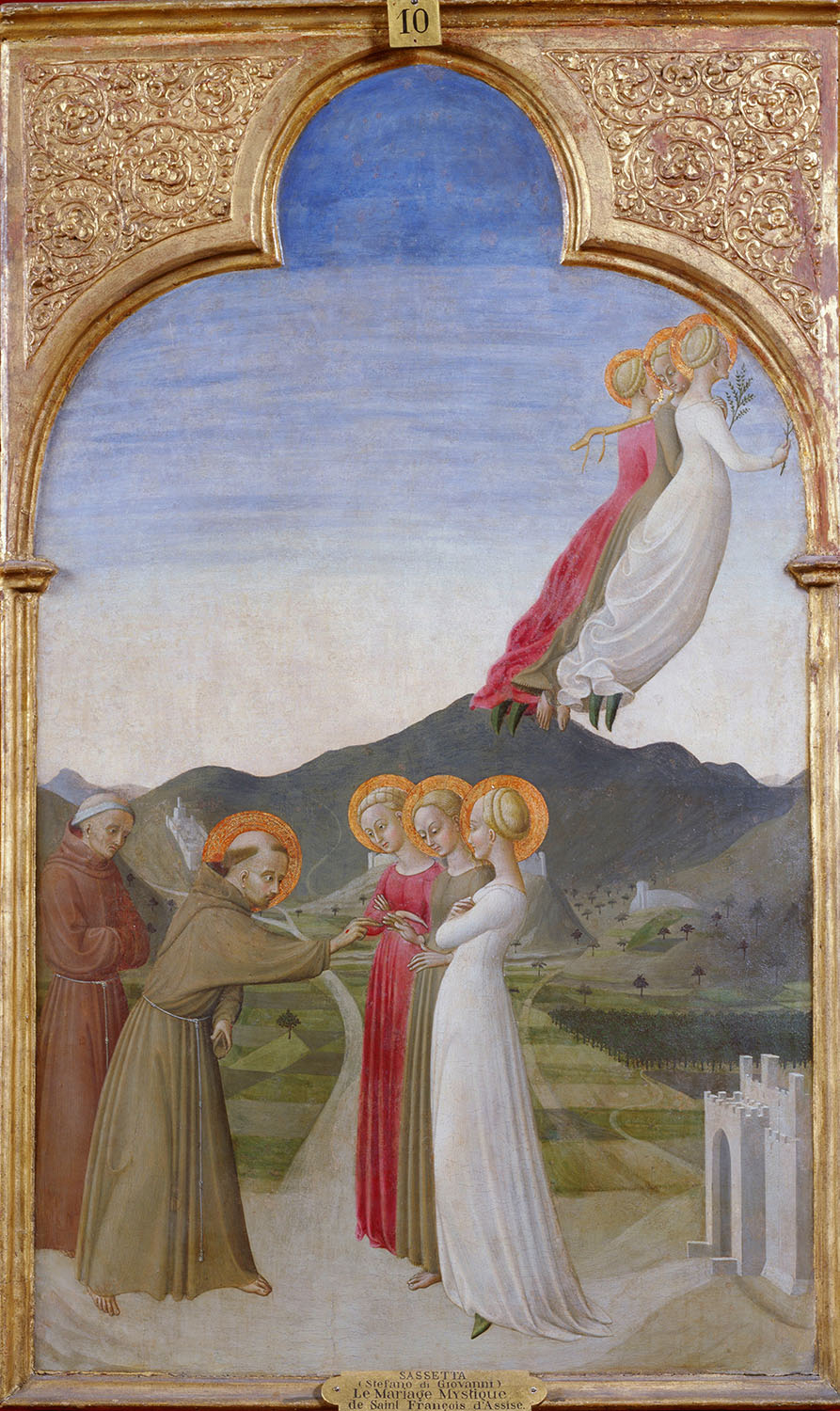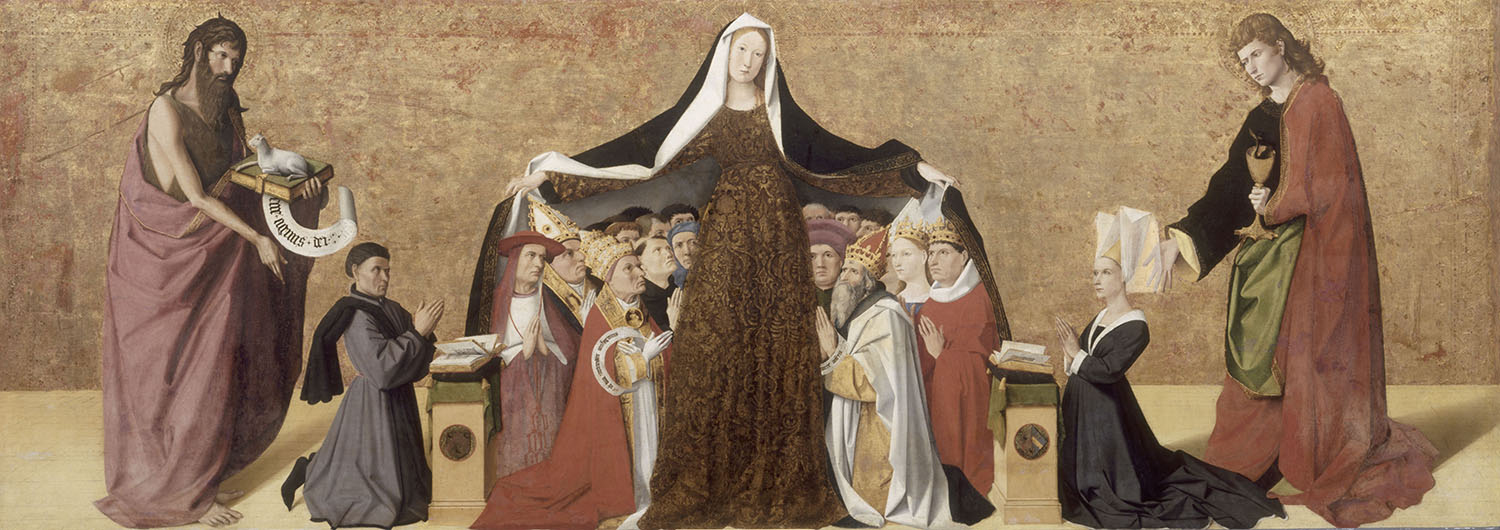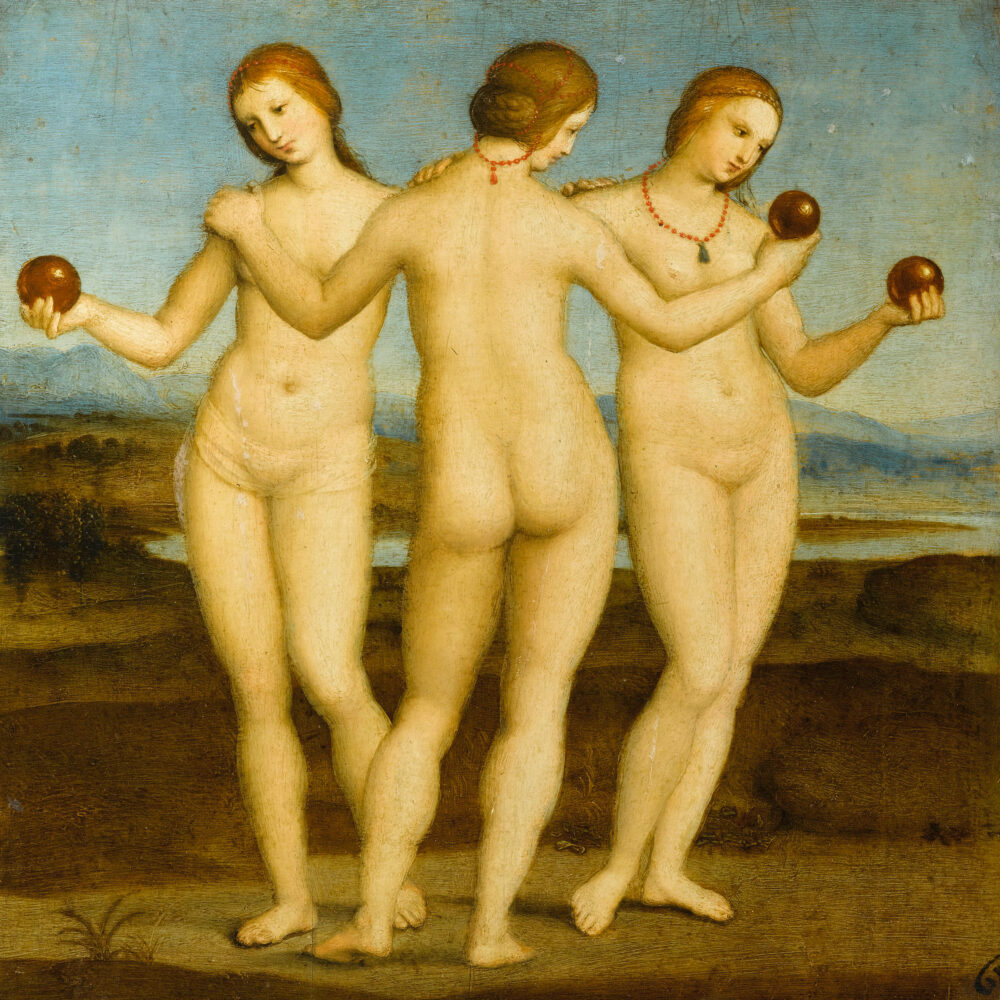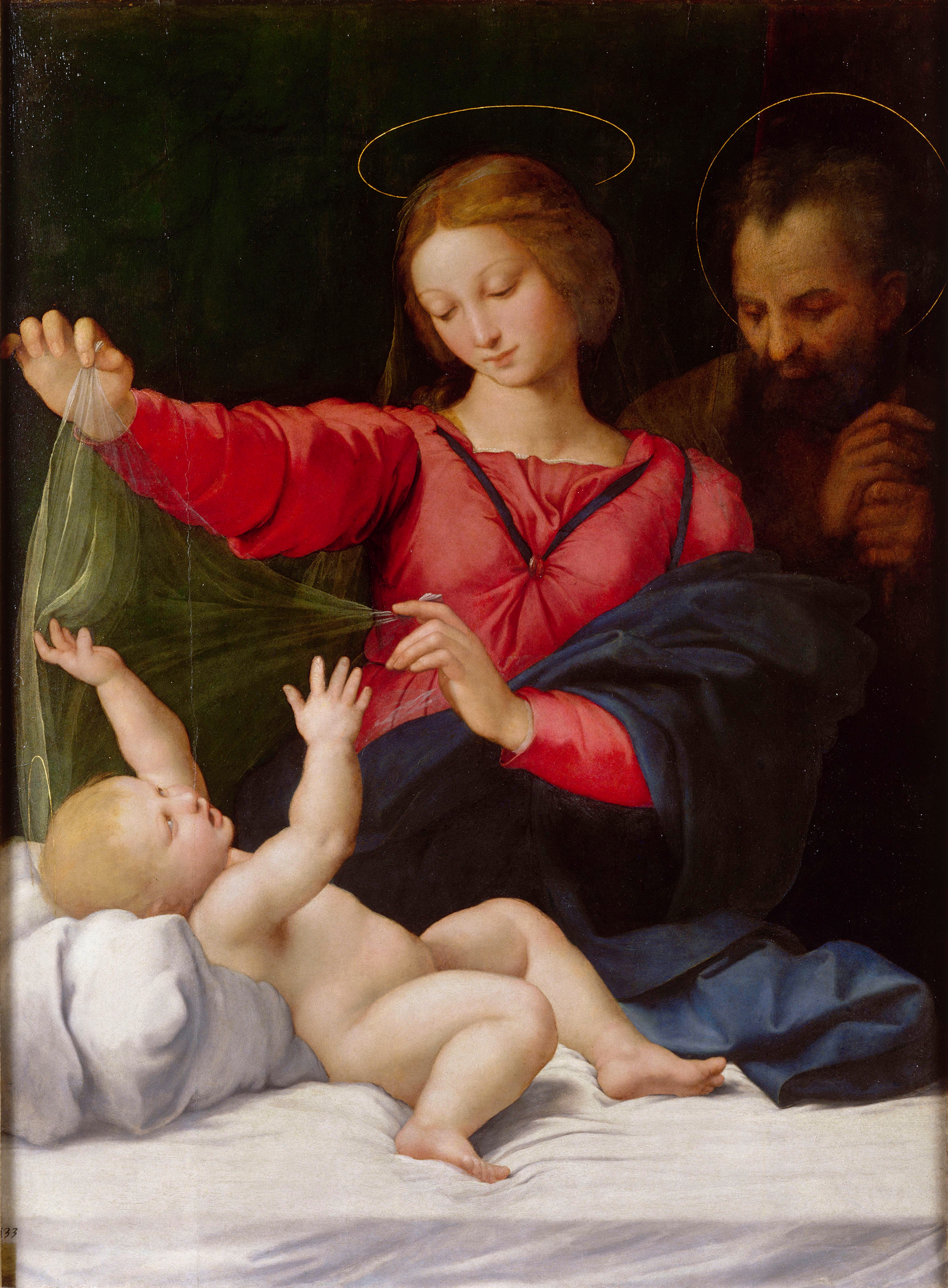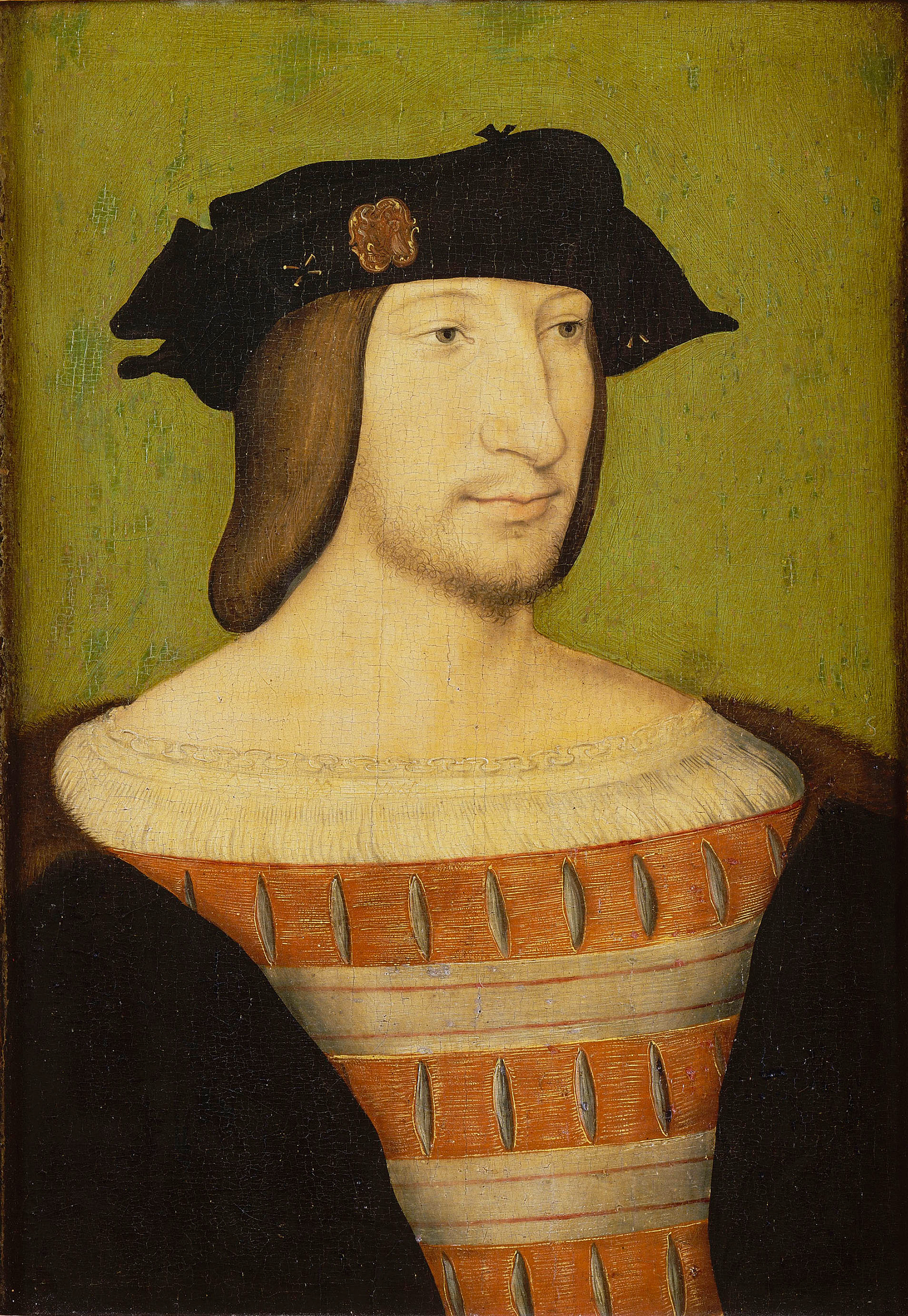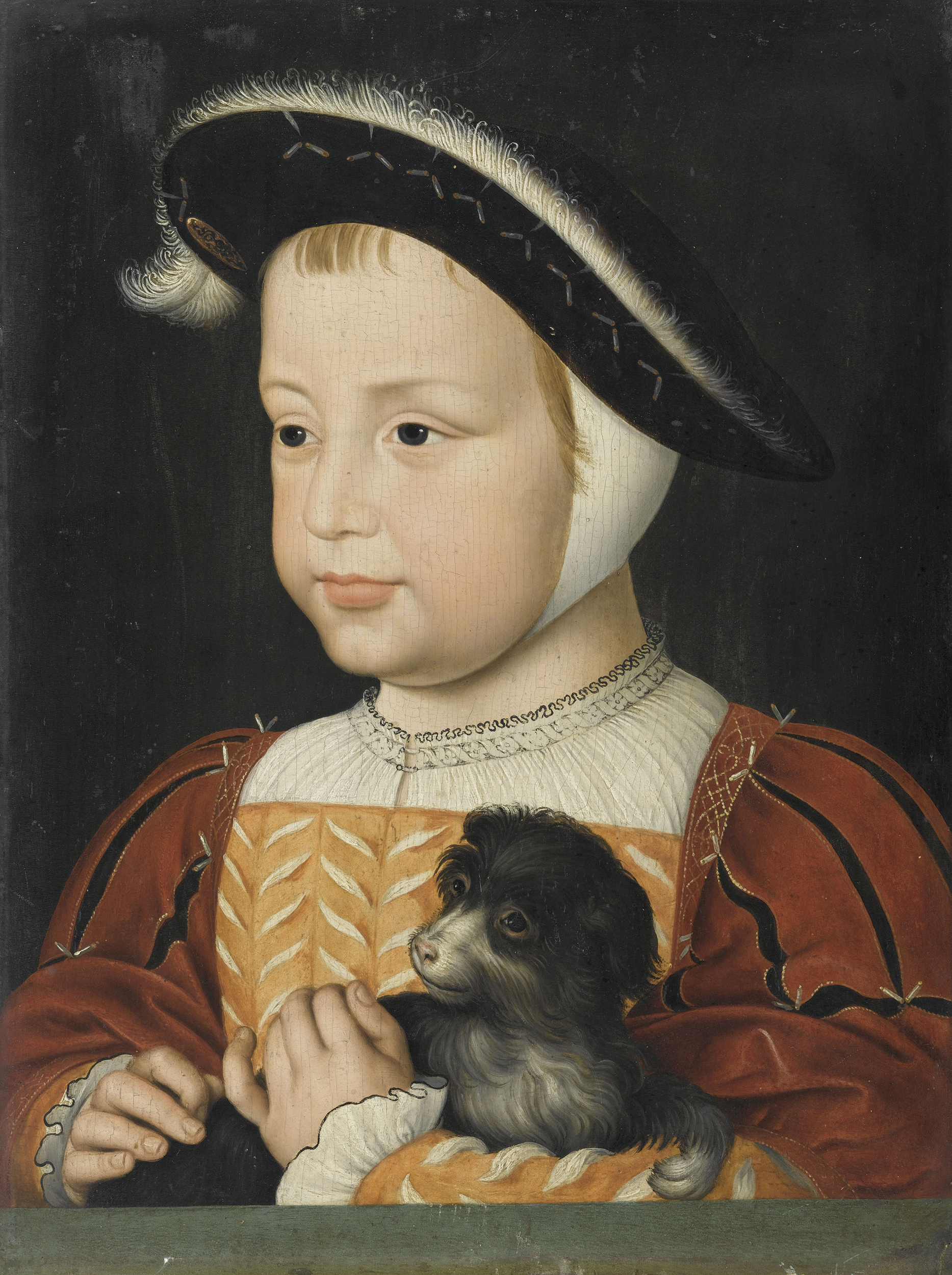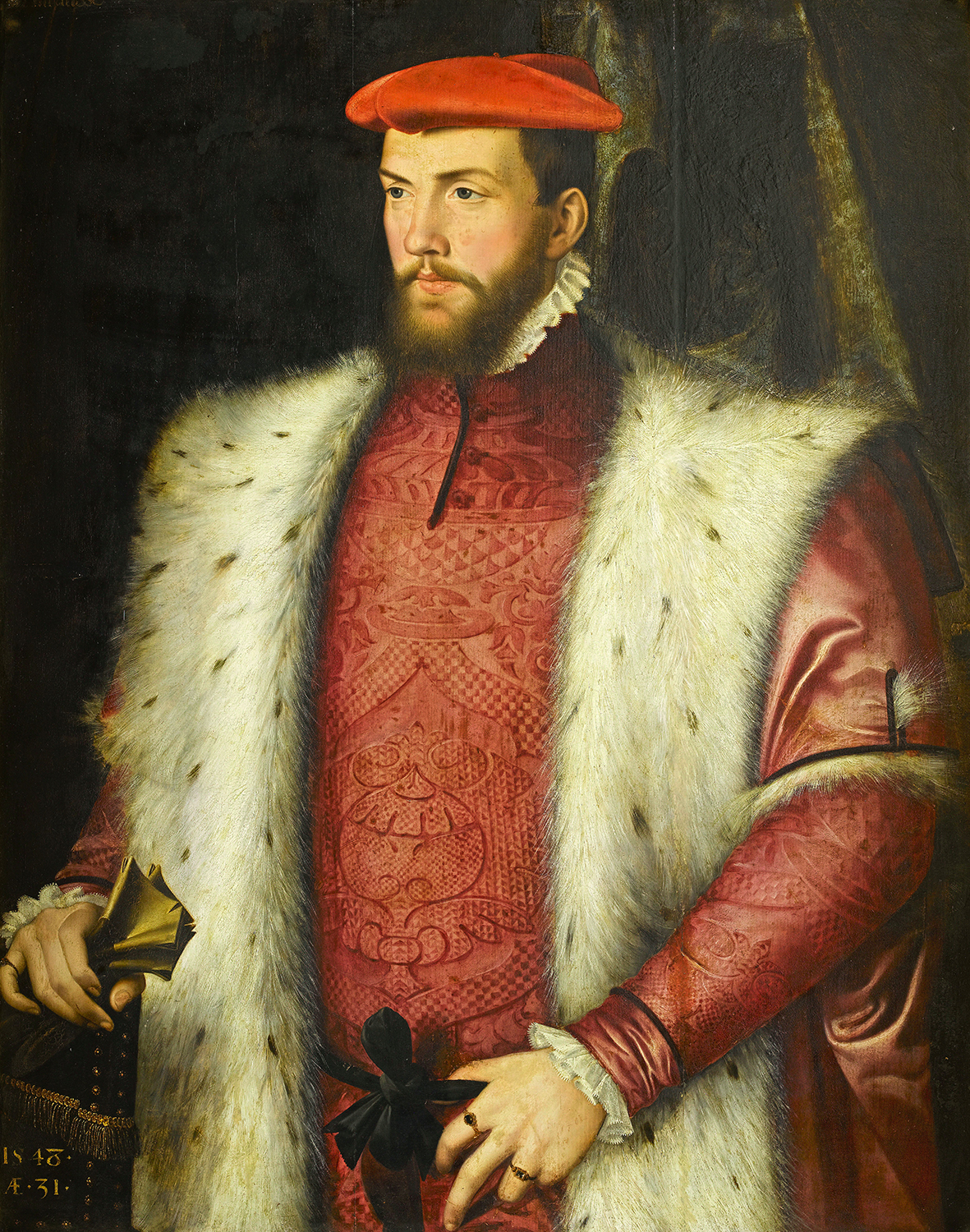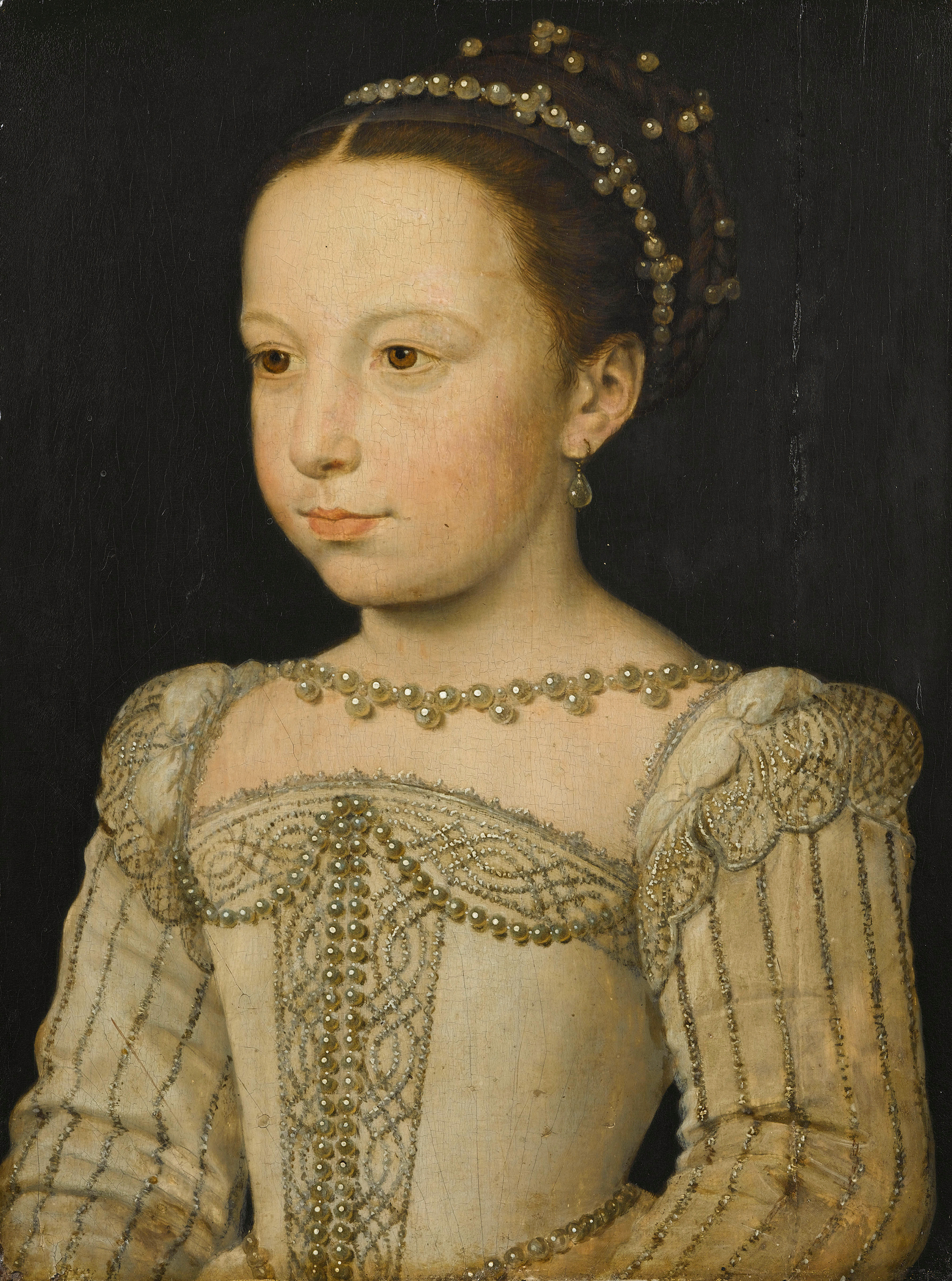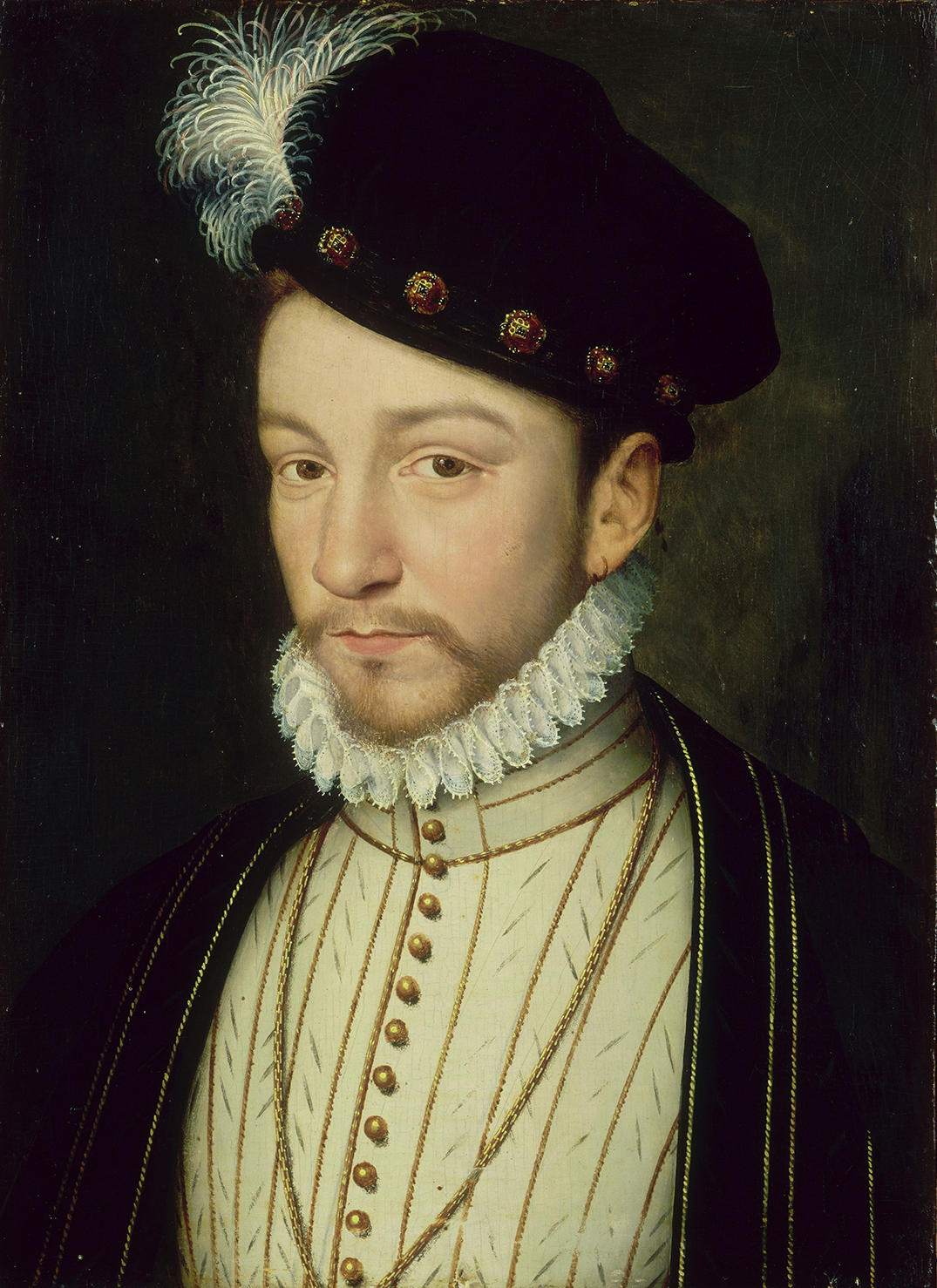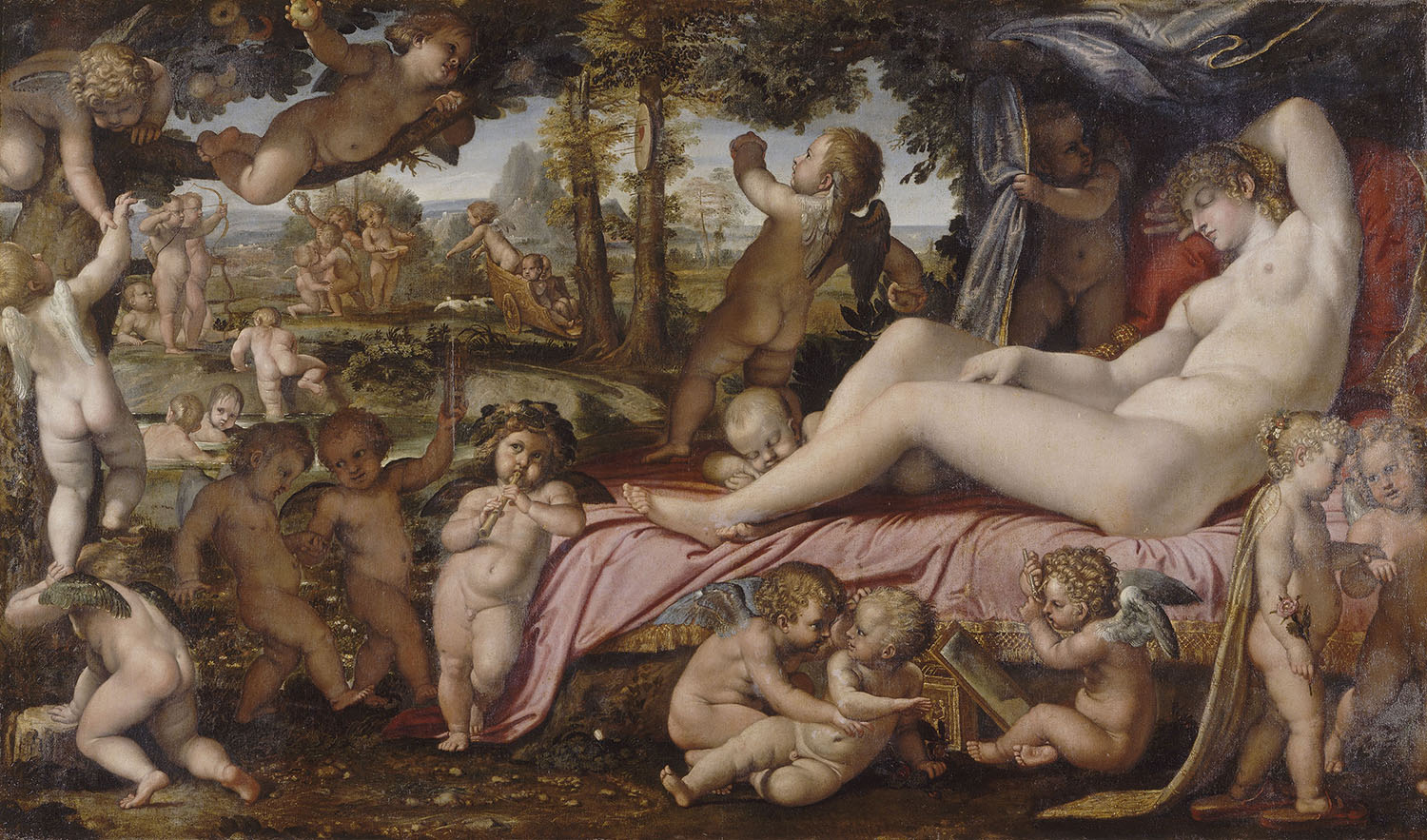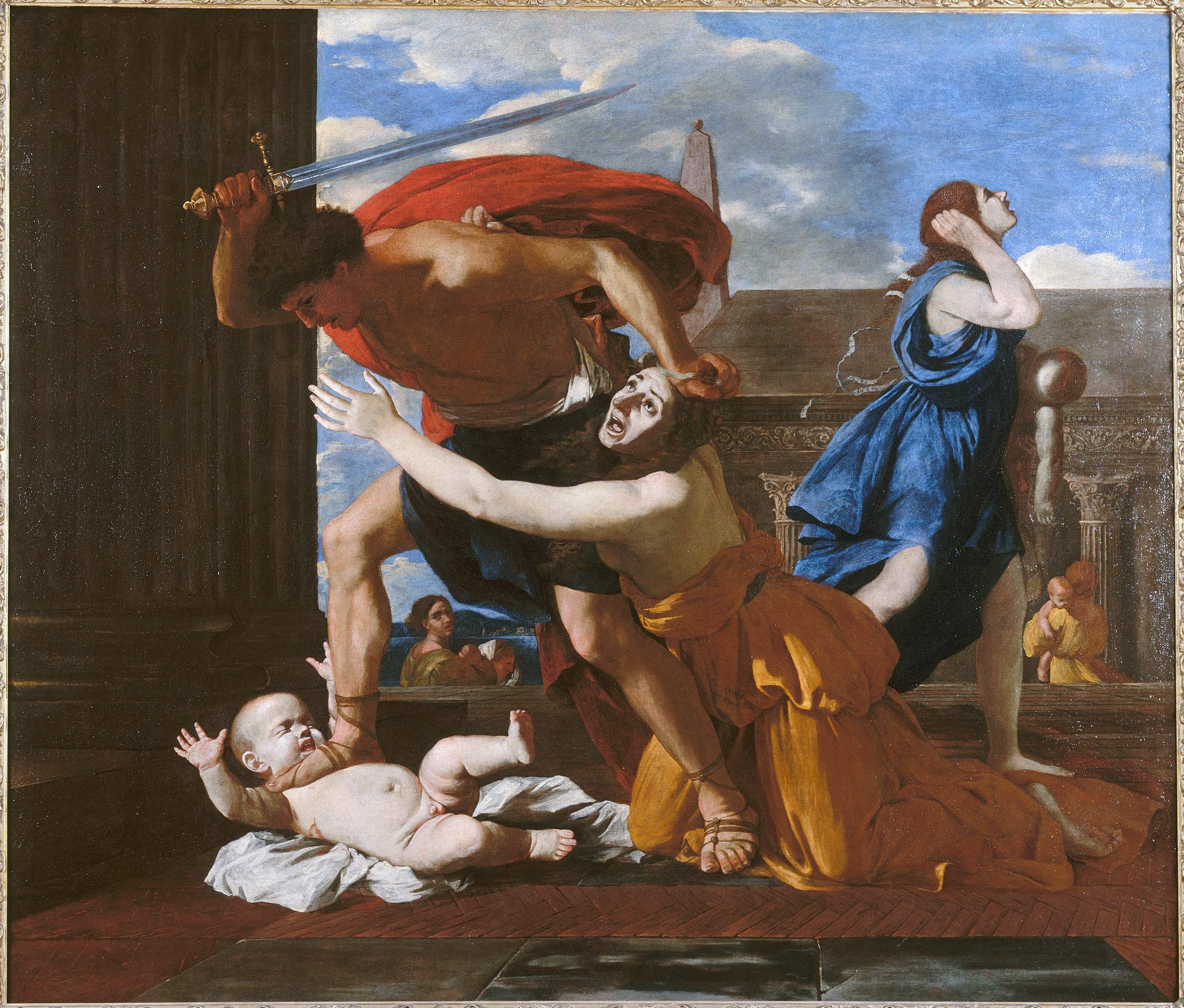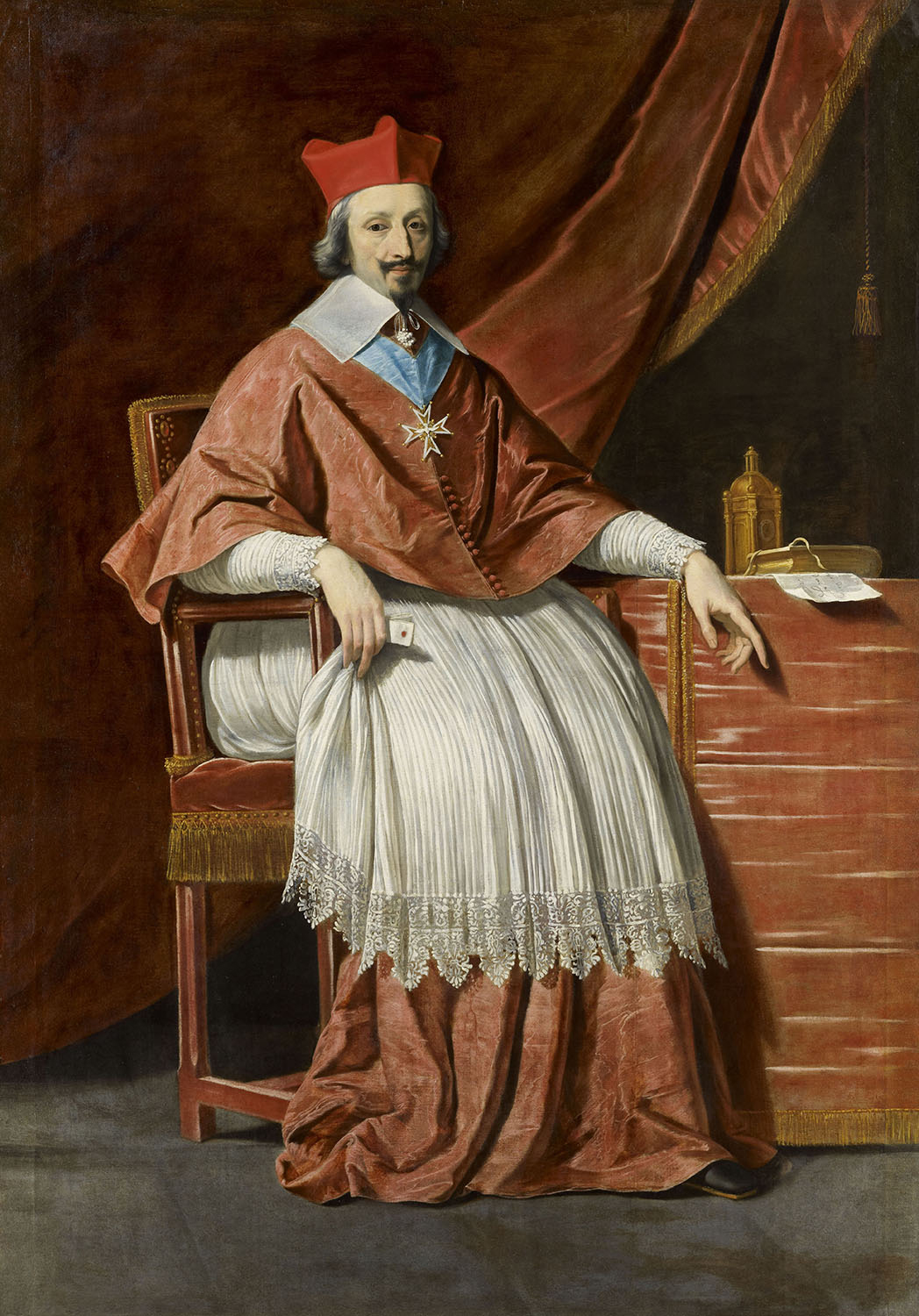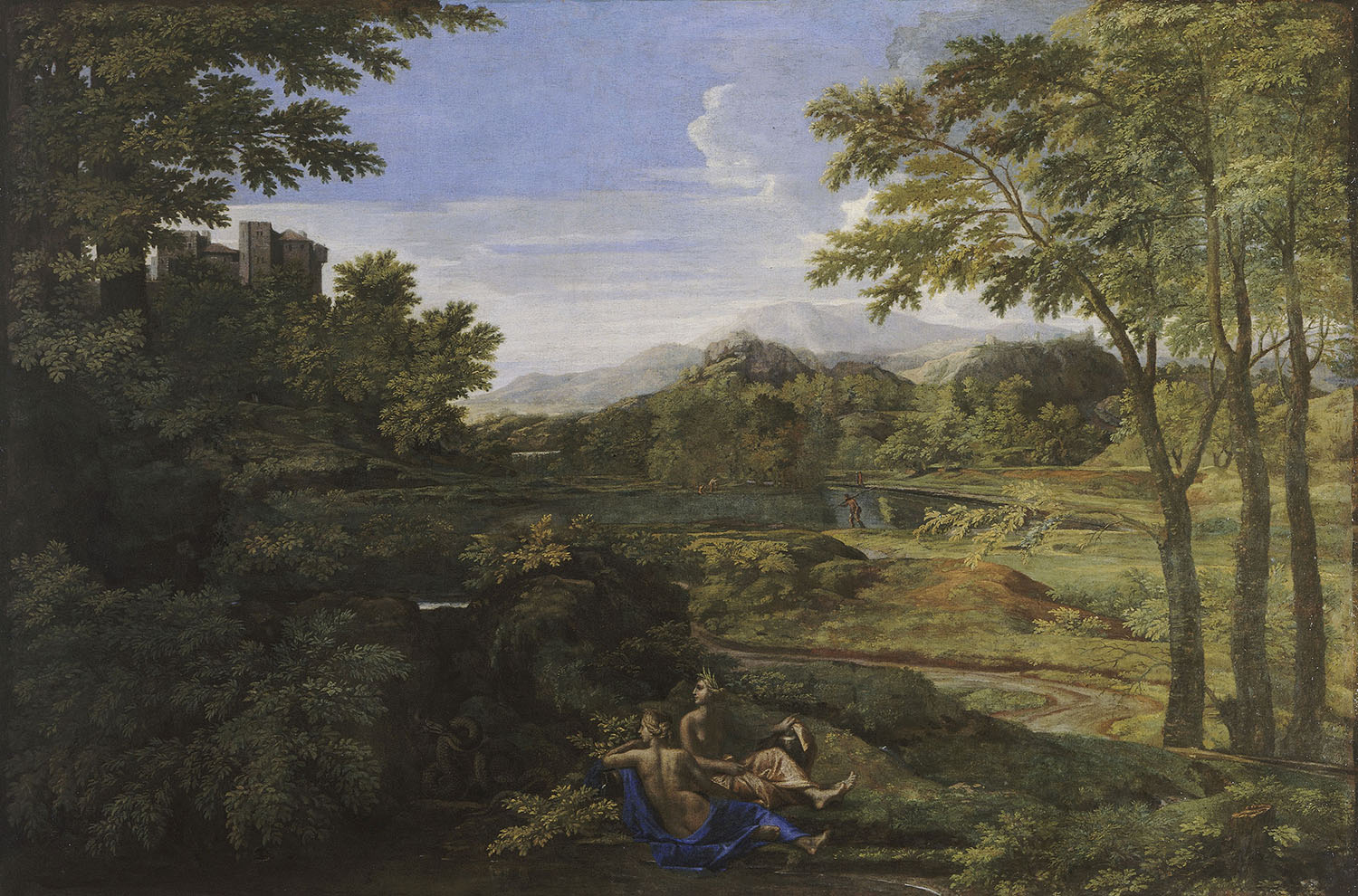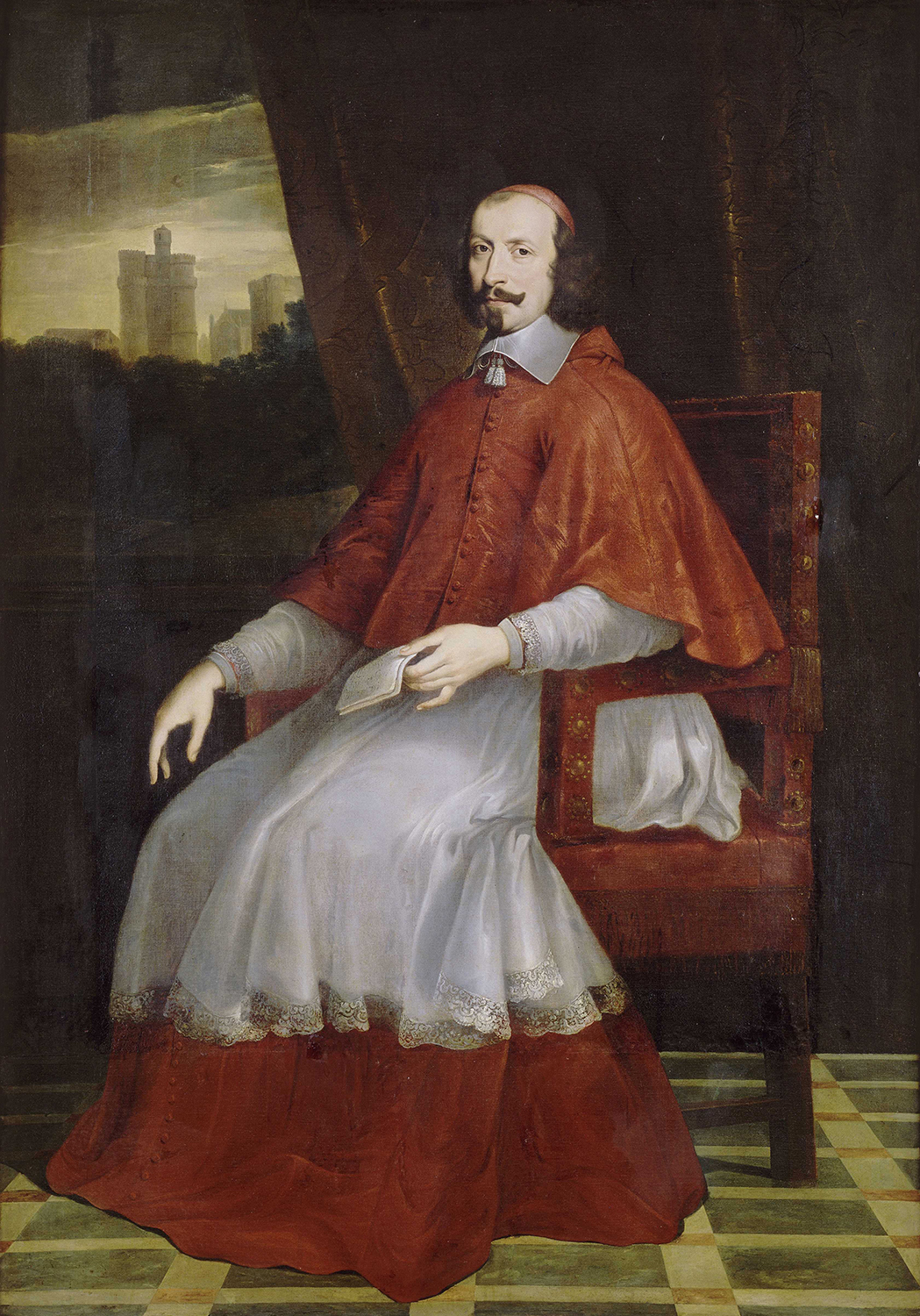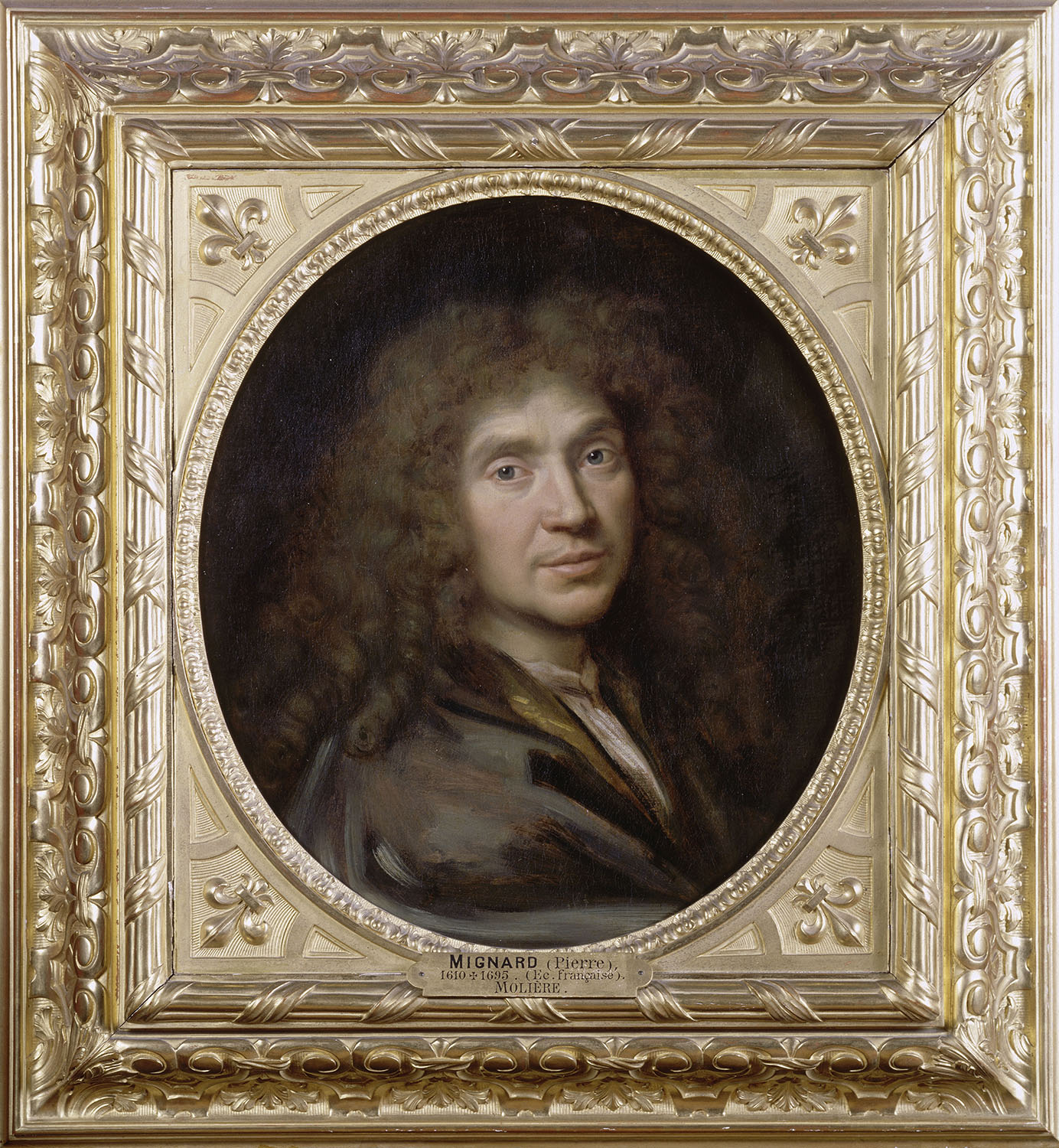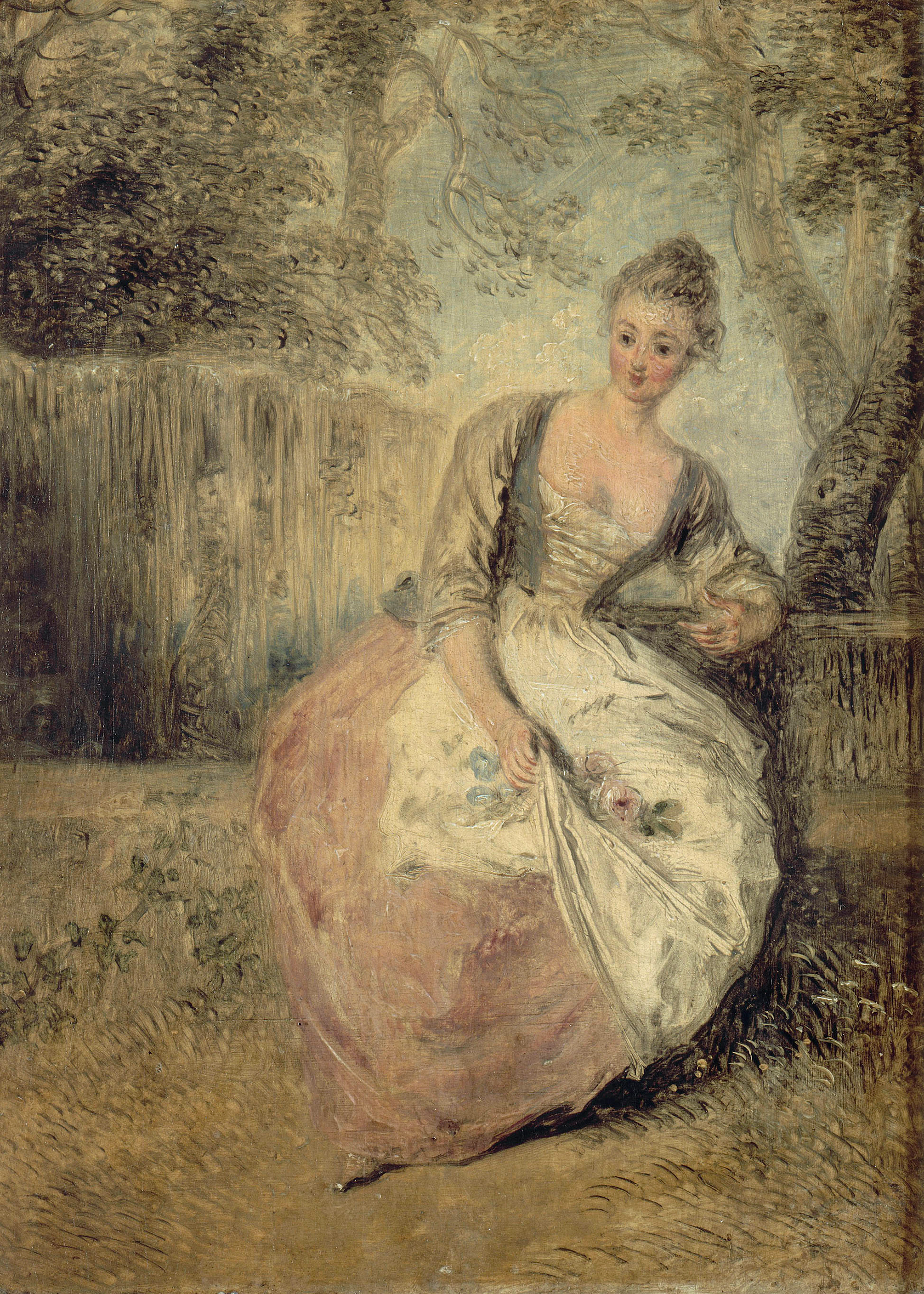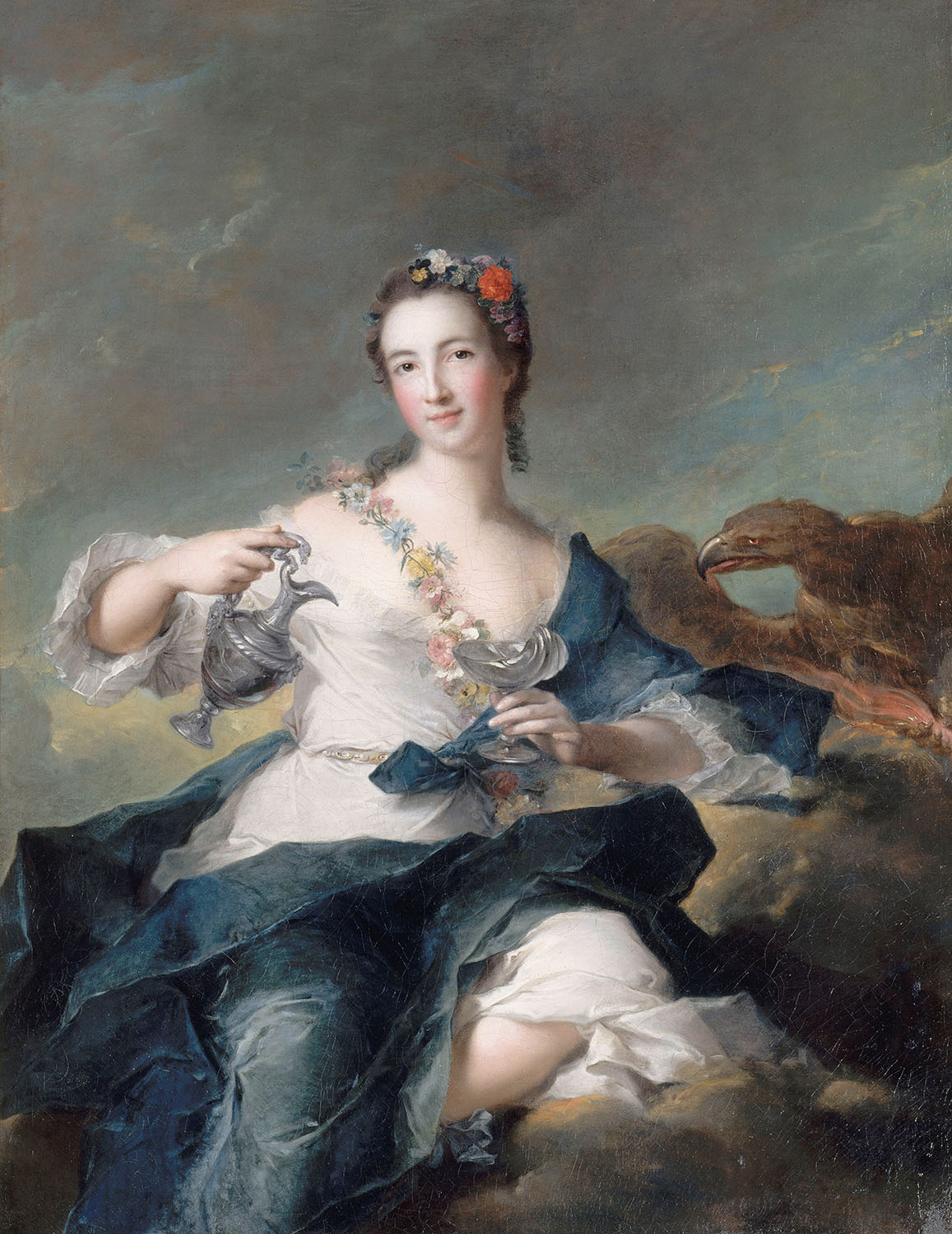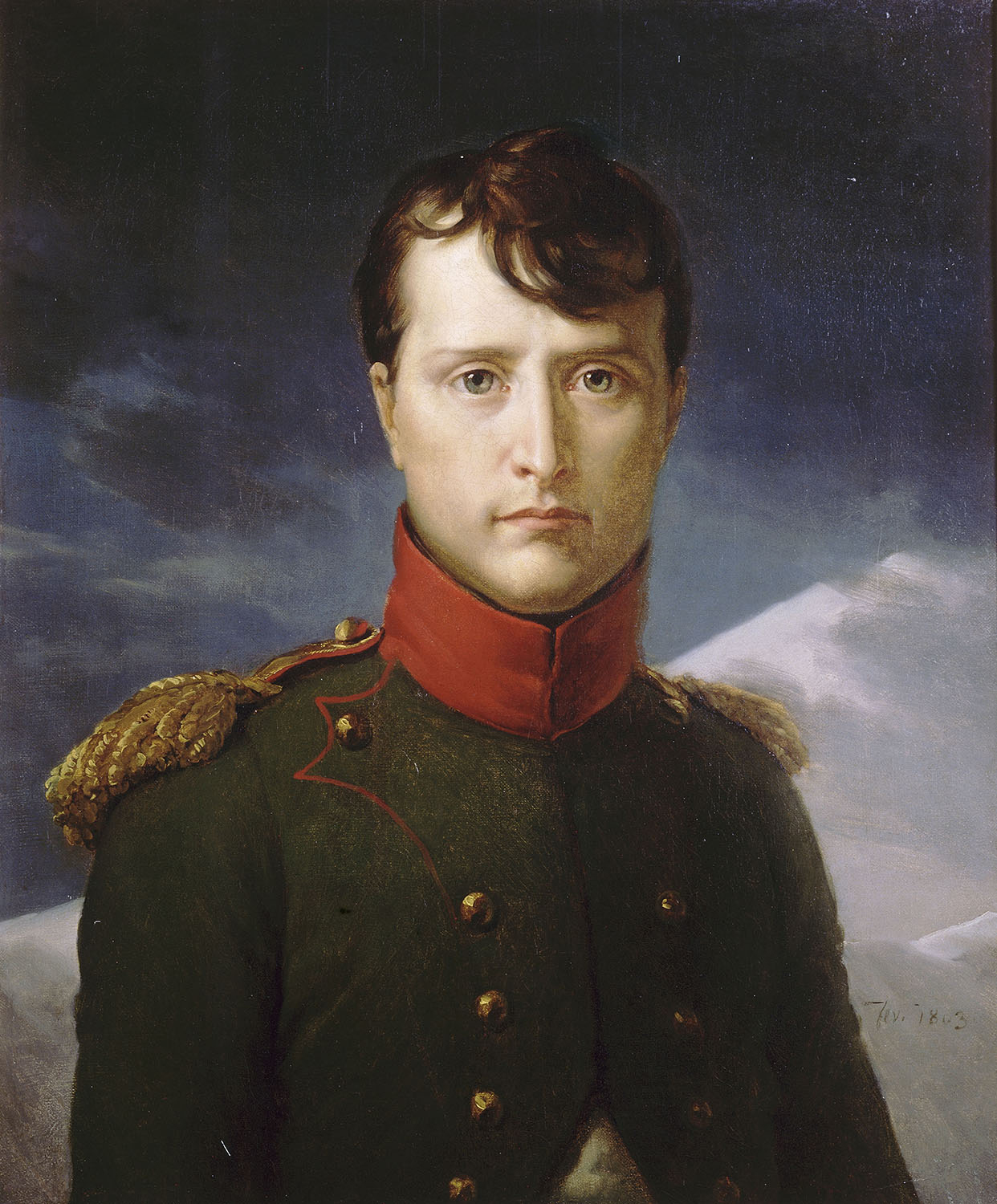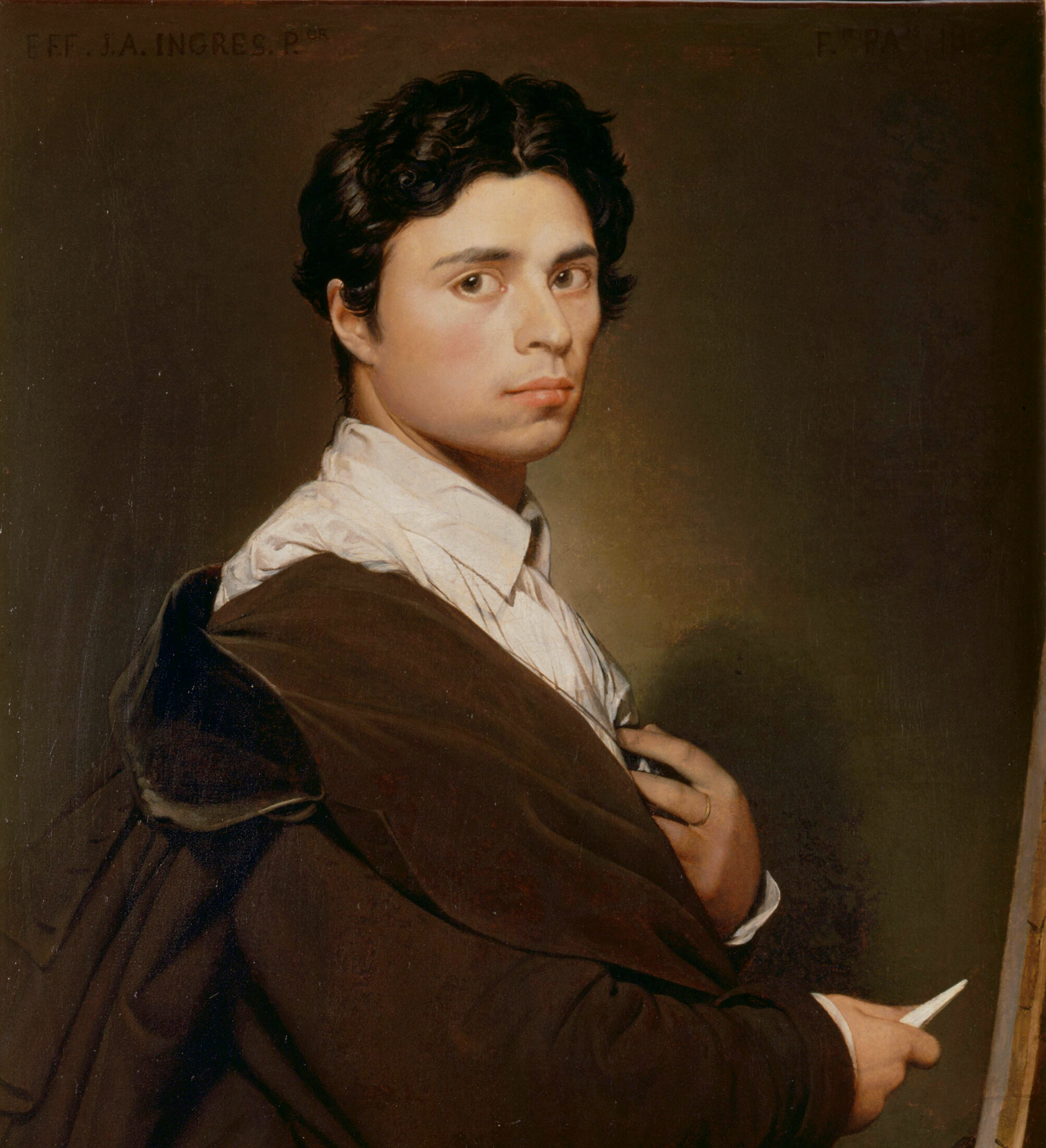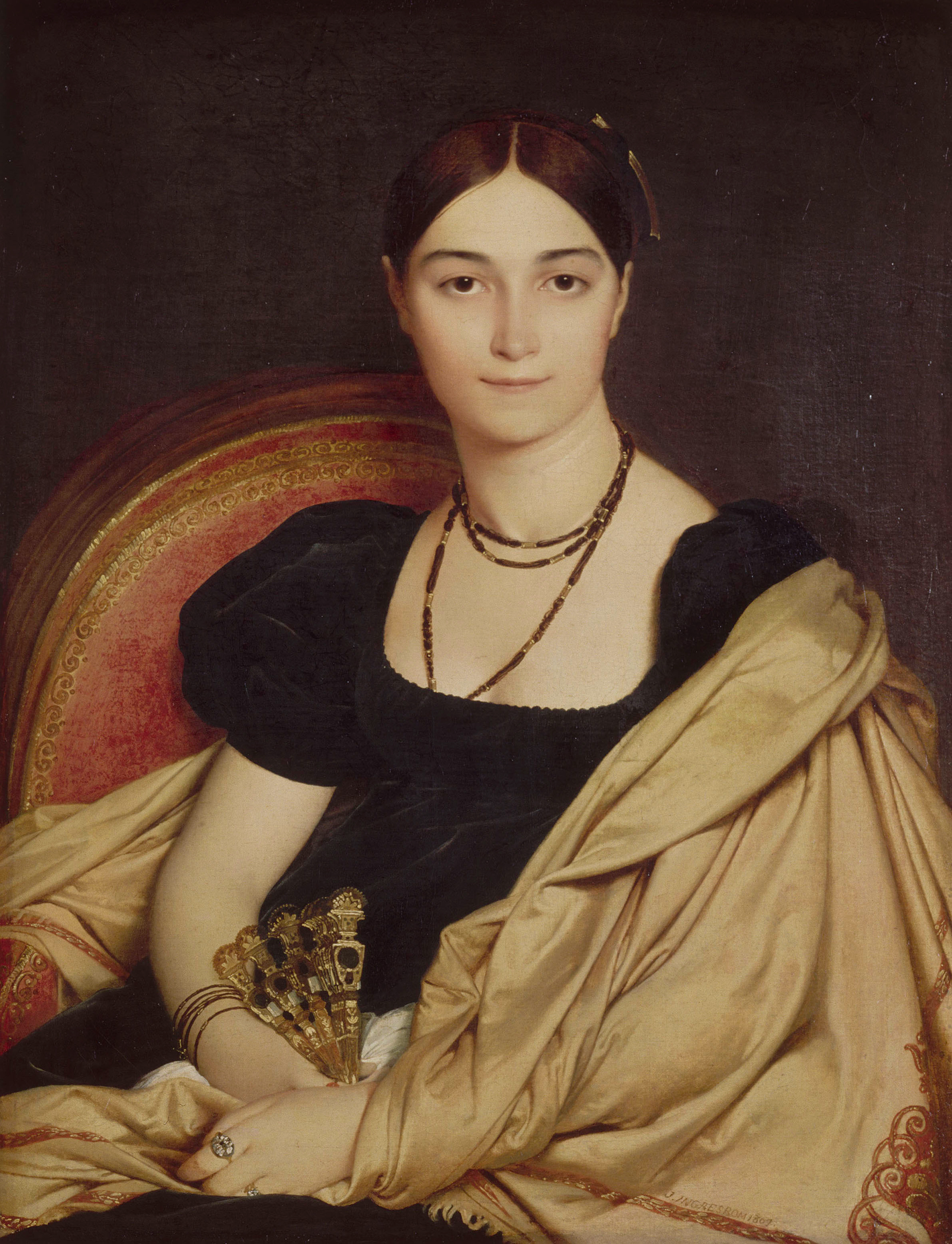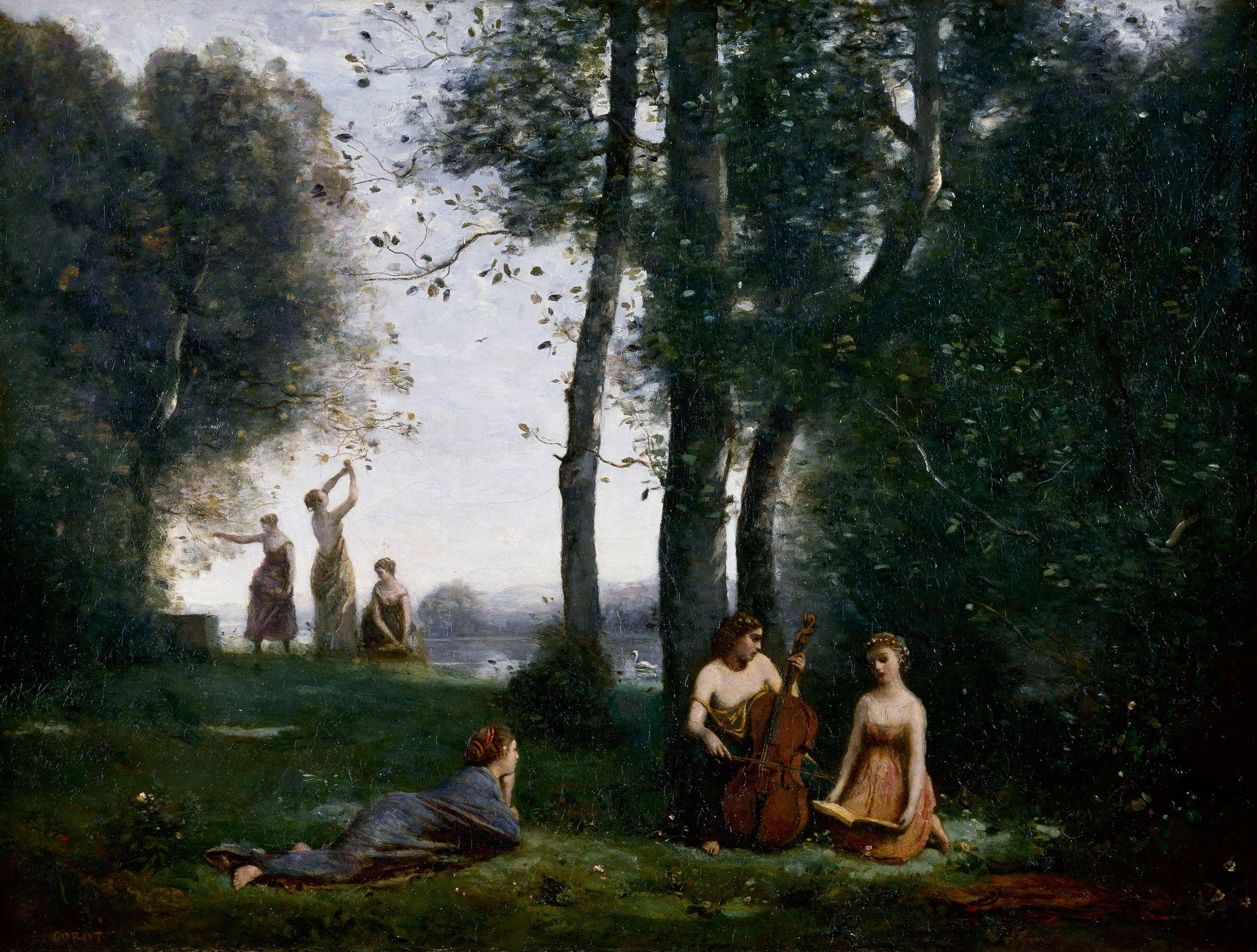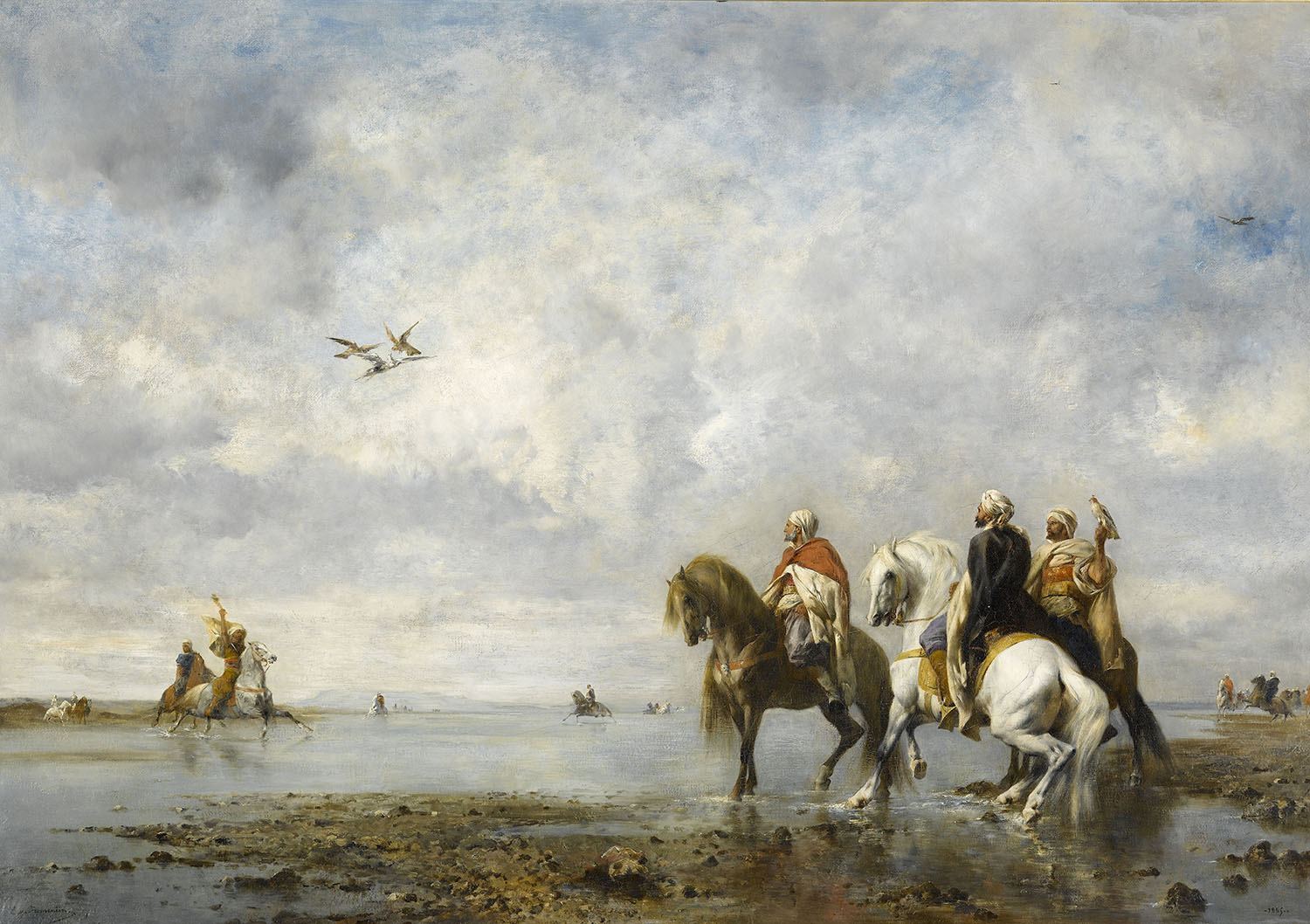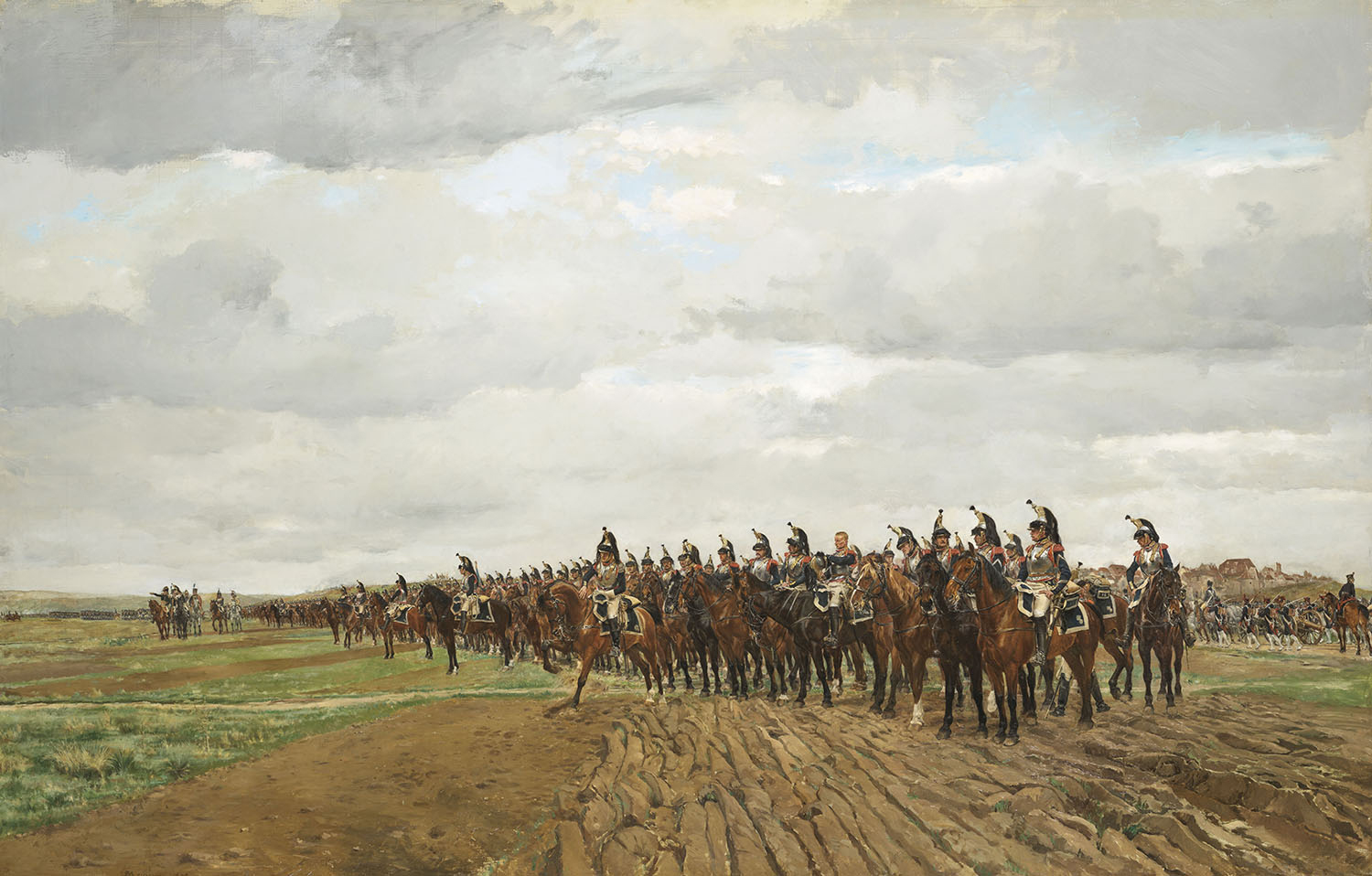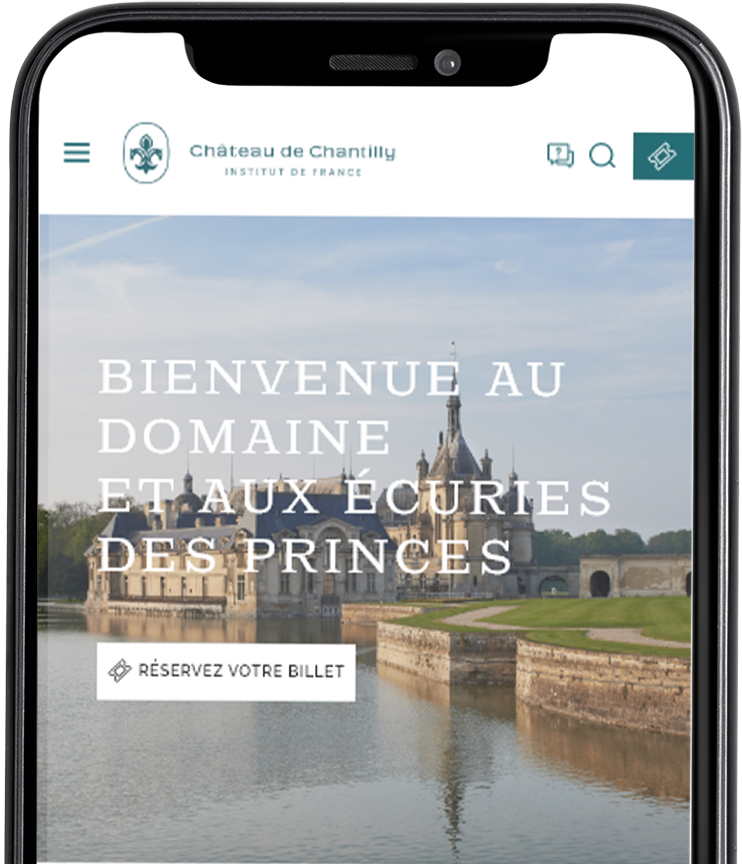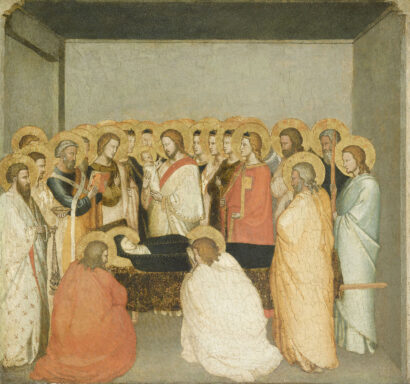
The Dormition of the Virgin
Maso di Banco
Circa 1335
The Giotto Room
The Dormition of the Virgin - Circa 1335
Artist : Maso di Banco
This work gave its name to the room in which it is exhibited: purchased by the Duke of Aumale in 1879, at the time it was attributed to the illustrious Florentine painter, architect and sculptor Giotto. It was subsequently attributed to one of his most loyal pupils, Maso di Banco. Gathered around the Virgin, the apostles are united around her remains, while her son Jesus Christ receives her soul, symbolised in the features of a child. The influence of his master can be seen in Maso’s sober, almost austere setting, the suggestion of depth, the presence of characters with graceful silhouettes, solidly rooted in the composition, which give particular power to the narration of the religious episode. However, he can be distinguished from Giotto by the purest evocation of shading in light colours, making him a discreetly elegant painter. According to a recent study, this panel was part of a triptych intended for the Prato Cathedral, two fragments of which are today held in Berlin and Budapest.
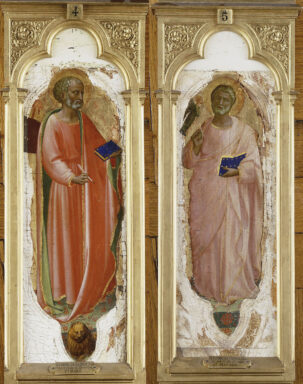
Saint Mark and Saint Matthew (San Domenico de Fiesole altarpiece)
Guido di Pietro, Fra Giovanni, known as Fra Angelico
Circa 1425
The Tribune
Saint Mark and Saint Matthew (San Domenico de Fiesole altarpiece) - Circa 1425
Artist : Guido di Pietro, Fra Giovanni, known as Fra Angelico
The two panels come from the high altarpiece of the church of San Domenico de Fiesole, very close to Florence, the church in Fra Angelico’s monastery. This monk and artist had trained in illumination: the minute detail of this technique can be seen in these works depicting the evangelists Mark and Matthew, recognisable by the lion and the angel, their attributes. The quill and the book highlight the time of writing of the gospels, inspired by the Word, as highlighted by the angel whispering in Matthew’s ear. The luminous use of colours on the gold background that would vibrate in the light of the church candles demonstrates the painter’s virtuosity. His characters, which are more embodied, with more lively garments, inaugurate a more human-centred approach, an interest in imitation of nature that animated Florence painters in the early 15th century.

Ecstasy of Saint Benedict in the Desert
Guido di Pietro, Fra Giovanni, known as Fra Angelico
Circa 1430
The Giotto Room
Ecstasy of Saint Benedict in the Desert - Circa 1430
Artist : Guido di Pietro, Fra Giovanni, known as Fra Angelico
This small panel is a fragment of a painting depicting scenes of the Thebaid, the desert region of Thebes in Egypt, where pious men lived as hermits, marking the origins of monasticism. It was perhaps intended for the Santa Maria degli Angeli monastery in Florence. In the centre, it featured the Three Dead and the Three Living, and scenes depicting the life of cenobitic monks. The panel was cut into several parts and today its fragments are dispersed among several international museums. Dismantling works in this way made it possible for art dealers, particularly in the 19th century, to make a higher profit by selling works with smaller formats, which were easier to sell. The luminous inventiveness of this landscape, surrounded by sea, and the gentleness emanating from the characters is typical of Fra Angelico, who was one of the great innovators of the first half of the 15th century in Florence, in particular in the area of altar paintings.
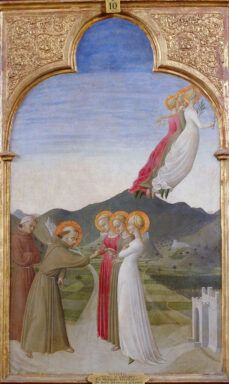
The Marriage of Saint Francis to Lady Poverty
Stefano di Giovanni di Console, known as Sassetta
1437-1444
The Tribune
The Marriage of Saint Francis to Lady Poverty - 1437-1444
Artist : Stefano di Giovanni di Console, known as Sassetta
This panel once adorned the reverse of a monumental polyptych, one of the most important of the first Quattrocento, commissioned in 1437 by the Franciscans for the high altar of the church in the Borgo San Sepolcro monastery (Tuscany). Made up of 60 panels, this polyptych was dismantled down through the centuries. Its surviving fragments are today dispersed across the world. This panel depicts Saint Francis giving up comforts and material goods. Poverty is embodied by a young woman dressed in brown, and Saint Francis puts the ring on her finger as Chastity (in white) and Obedience (in red) look on with satisfaction. The three allegorical figures fly away afterwards: only Poverty looks back. Sassetta was one of the Masters from the Sienese School in the Quattrocento. Although his style is marked by the International Gothic style, with its slim, elegant figures dressed in flowing garments, this panel demonstrates his approach to landscape as an accessible space, indicating his knowledge of Florentine innovations.
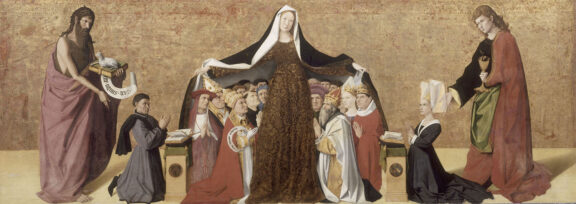
The Virgin of Mercy
Enguerrand Quarton
1452
The Giotto Room
The Virgin of Mercy - 1452
Artist : Enguerrand Quarton
Here the Virgin is depicted in the traditional iconography of the Byzantine tradition, wrapping her coat around the faithful. On the left, religious men, from the most powerful to the humblest, and on the right, lay people, from sovereigns to the poorest in society. On either side, Saint John the Baptist and Saint John the Evangelist introduce the donating couple, Jean Cadard, of whom they are the patron saints, and his wife. The panting was commissioned in 1452 for their son, Pierre, in memory of his parents, for the Saint-Pierre chapel in the Celestine church in Avignon. At that time, the former papal enclave was a major trade crossroads that attracted painters from all horizons. The monumentality of the figures, the rigorous composition, intense colours and striking silhouettes can also be found in Enguerrand Quarton’s other works, such as the Pietà of Villeneuve-lès-Avignon (Louvre museum).
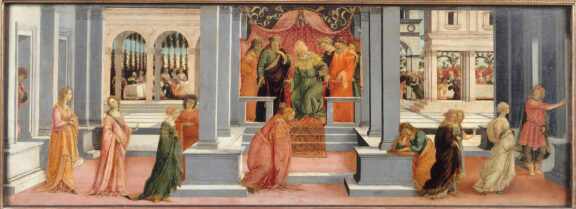
Esther Chosen by Ahasuerus
Botticelli and Lippi
Circa 1475
The Santuario
Esther Chosen by Ahasuerus - Circa 1475
Artist : Botticelli and Lippi
This panel is a wonderful testament to the Italian Renaissance. In the 15th century, when young girls from good Florentine families got married they were given a “cassone” or marriage chest, in which they could keep their finery and jewels. The paintings on the sides of these chests were generally scenes relating to love and marriage. This panel depicts a story taken from the Bible : the story of Esther and Ahasuerus. Filippino Lippi (1457-1504) was a student of Botticelli in Florence, and here we see slender figures inspired by his master’s style. The painting is also a magnificent illustration of the rules of perspective.

Simonetta Vespucci
Piero di Cosimo
Circa 1480
The Rotunda
Simonetta Vespucci - Circa 1480
Artist : Piero di Cosimo
It is said that Simonetta Vespucci was one of the most beautiful women in Florence in the middle of the 15th century. She was a model for Botticelli. Although the portrait is an ode to beauty, it is also a posthumous tribute. Simonetta Vespucci died prematurely, aged twenty-three, from tuberculosis. In memory of the young woman, following her death, Giuliano de Medici, brother of Lorenzo the Magnificent, commissioned the painting from Piero di Cosimo (1462-1521). The symbolism depicting the snake evoking the eternal cycle of life and the dead trees on one side, and the live trees on the other, evokes the brief destiny of the model and the cycle of life.
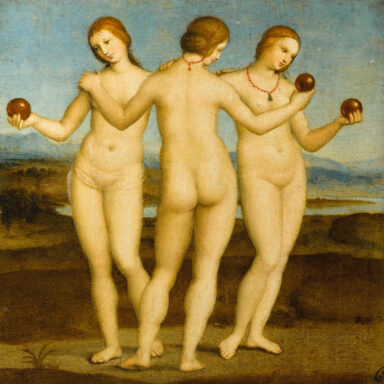
The Three Graces by Raphael
Raphael
between 1504 and 1505
The Santuario
The Three Graces by Raphael - between 1504 and 1505
Artist : Raphael
This painting is the smallest in Chantilly but also the most precious: inspired by an antique marble statue, it is one of the few profane works painted by Raphael (1483-1520). An X-ray of the painting revealed that its composition had been changed by the artist: originally, only one of the three women was holding a golden ball in her hand. This would be a depiction of the Judgement of Paris and the three Greek goddesses: Hera, Athena and Aphrodite. Subsequently, Raphael changed his mind and put an apple in each woman’s hand, making them Hesperidia, who conferred immortality to humans by giving them apples.
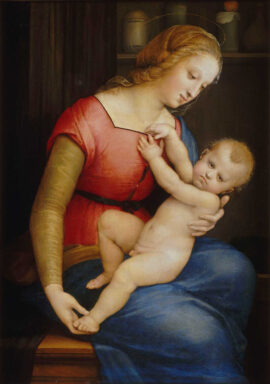
The Madonna of the House of Orléans
Raphael
Circa 1506-1507
The Santuario
The Madonna of the House of Orléans - Circa 1506-1507
Artist : Raphael
Until the Revolution, this painting by Raphael (1483-1520) belonged to the Orléans’ collection, from which it takes its title. In 1791 Louis-Philippe-Joseph of Orléans sold his paintings and the painting was taken to England, where the Duke of Aumale bought it back in 1869 because of its family origins. This is a magnificent example of the devotional Virgins painted by Raphael in his youth. The jar of “tyriana” in the background is a remedy against bites inflicted by snakes, the symbol of evil. The tyriana and the apple symbolise Christ’s atonement for original sin.

The Madonna of Loreto
Raphael
1509
The Rotunda
The Madonna of Loreto - 1509
Artist : Raphael
Up to 1976, this painting was considered to be the copy of a lost original by Raphael (1483-1520). When it was restored, the number 133 was identified in a corner of the painting, corresponding to the number that featured on the original by Raphael in the Borghese collection in Rome. This small rectangle demonstrates how darkened the painting had become prior to its restoration. It also explains why the specialists initially did not recognise it as the work of the great Italian master of the Renaissance. This family scene depicting the Virgin holding a veil over her son is a pretext to evoke the tragic destiny of Jesus: the veil traditionally symbolises the shroud of Christ.
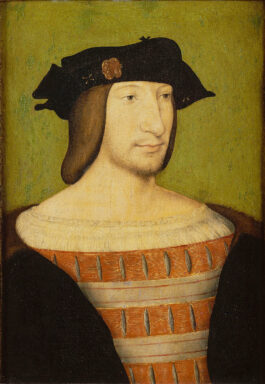
Portrait of François I
Jean Clouet
Circa 1515
The Clouet Room
Portrait of François I - Circa 1515
Artist : Jean Clouet
One of the most famous portraits in the Clouet room, depicting François I, King of France from 1515 to 1547. François has just become king and won the battle of Marignan. The young monarch, who had an impressive build, is depicted here looking calm yet determined. Dressed in a simple ochre coloured doublet with slits, he is wearing neither a crown nor any royal insignia. This portrait is highly characteristic of Jean Clouet’s (1480-1541) style. The facial features are very realistic, in the Flemish style. The pose is hieratic and majestic, and the model is generally not looking at the spectator.

Portrait of Henri II as a child
Jean Clouet
1524
The Clouet Room
Portrait of Henri II as a child - 1524
Artist : Jean Clouet
At the beginning of the 16th century, Jean Clouet, and then his son François, popularised a court portrait formula. Author of the famous Portrait of François I (Louvre Museum), at the same time, Jean Clouet painted the King’s children. He launched a veritable pictorial genre, that of the children’s portrait, subsequently perpetuated by his son. The formula established by the Clouets features the three-quarters bust model, evoking the Nordic tradition, but with particular attention to likeness of features and the psychology of the person in the portrait. Always reserved, as was customary at court in the period, sometimes discreetly smiling, models are depicted in the splendour of their finery and rank. Here, Clouet focuses on the spontaneity of childhood behind the well-behaved expression of the young prince, holding his puppy in his arms. Henri II’s wife, Catherine de Medici, also commissioned a series of portraits of her children from François Clouet.
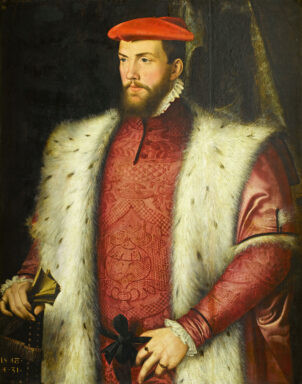
Portrait of Odet de Coligny, Cardinal of Châtillon
François Clouet
Circa 1548
The Rotunda / The Gallery of Painting
Portrait of Odet de Coligny, Cardinal of Châtillon - Circa 1548
Artist : François Clouet
Here, François Clouet depicts the Cardinal of Châtillon using a formula different to that of his drawings: the model is portrayed from the waist up, standing in front of a drape, lavishly dressed, holding his glove in his right hand. The formula evokes those practised by Titian or Bronzino. However, it is to Clouet and not Primatice, as indicated in the inscription, that this portrait must be attributed, by analogy with another painted portrait and another drawn portrait. The textures of his ermine stole, his beard, and the opulent scarlet garment are painted with flawless precision, which further adds to the model’s splendour. It is thanks to constable Anne de Montmorency, his uncle, that Odet de Coligny received his cardinal’s hat in 1533, at the age of sixteen. He gradually opened up to the ideas of the Reform and defended protestants at court. He converted, was threatened by Catholics and excommunicated in 1563. He found refuge in England, where he died, perhaps from poisoning, without having managed to join his brother Gaspard de Coligny, whose murder marked the start of the Saint Bartholomew’s Day massacre.
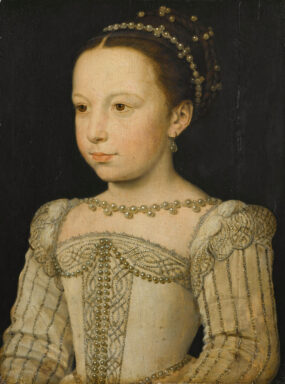
Portrait of Marguerite de Valois as a child
François Clouet
Circa 1560
The Clouet Room
Portrait of Marguerite de Valois as a child - Circa 1560
Artist : François Clouet
The Clouets prepared their portraits with charcoal, sanguine or white chalk drawings, sometimes enhanced with ink wash or watercolour. These “crayons” (sometimes synonymous for “portrait”), became works in themselves, collected and kept by the most powerful people in the kingdom, such as King François I or Queen Catherine de Medici. The Condé Museum is home to the preparatory drawing for this beautiful portrait, which translates the vivacity and seriousness of this young princess, later described by chroniclers as a spiritual, cultivated woman, a witness to the Saint Bartholomew’s Day massacre and a controversial member of court. In this portrait, Queen Margot, the future wife of Henri IV, reveals the luxury of the Valois court in the skilfully rendered lace and lustrous pearls.
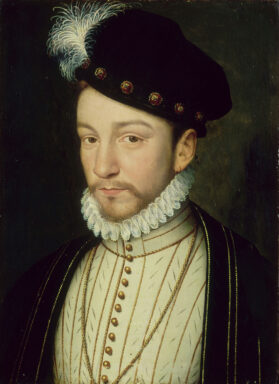
Portrait of King Charles IX
François Clouet and workshop
1570
Portrait of King Charles IX -
Artist : François Clouet and workshop
The portraits of Charles IX in Chantilly show the evolution of the sovereign from childhood to adulthood. This portrait is the result of a new commission for François Clouet from the young Valois King in 1570. Yet barely a year previously, the artist had painted a beautiful full length portrait with large dimensions, which was sent to Vienna with a view to his marriage to Elisabeth of Austria, of which the Condé Museum has a reduced scale copy. But the King felt he looked too young in it. In this three-quarter length portrait, Clouet did not change the depiction of the King, who is still wearing his luxurious cap. He added the thin moustache and beard of the young man, barely twenty years old. The King was not happy with it and demanded that Clouet make him look older. In this way, the sovereign’s youthful round features were replaced by a thinner face, whose paleness reflects his poor health. The King in fact died from tuberculosis at the age of 23.
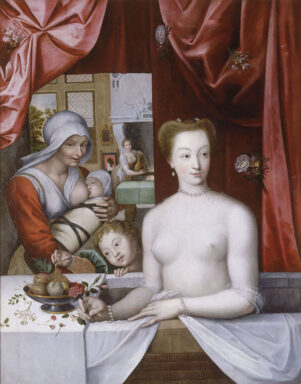
A Lady in her bath
French School
Late 16th century
The Gallery of Painting
A Lady in her bath - Late 16th century
Artist : French School
Iconography depicting women bathing, popularised in the 16th century in France, was a manifestation of the reception given to La Joconde nue by Leonardo da Vinci or his school (the sketch of which is held by the Condé Museum). There are indeed echoes of this nude beauty, depicted from the waist up with her face turned sideways, in the context of bathing, which was recommended for women after childbirth. The composition of the “Lady in her bath” is inspired by a François Clouet painting (held in Washington). The latter was himself inspired by La Joconde nue. It shows a new-born in the arms of a nurse, who gives the spectator a look that is almost complicit, while a mischievous child pinches some fruit from the bowl. Flowers, fruit, nudity and erotic sensuality subtly mix the theme of motherhood with that of Venus and Flora. The model was long believed to be Gabrielle d’Estrées, a favourite of King Henri IV and the mother of two of his children.
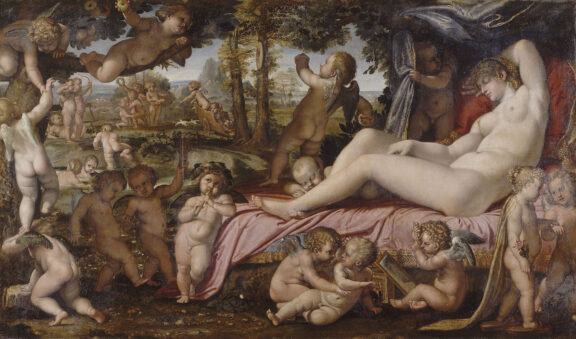
Sleeping Venus
Annibale Carracci
1602
The Gallery of Painting
Sleeping Venus - 1602
Artist : Annibale Carracci
Annibale Carracci, who was responsible for a renewal in painting in Rome, was the most prolific and the most successful of the Carracci. Together with his brother Agostino and his cousin, Ludovico, he founded a school for artists in Bologna. This institution trained a new generation of painters that thrived in Rome, with commissions from the Pope and his entourage. With the décor of the Palazzo Farnese, firstly Annibale and then Agostino, proposed a new pictorial language, inspired by the Renaissance, but going beyond mannerism, which they countered by a more classic monumentality, combined with vitality and sensual energy. This is the vein in which Sleeping Venus was painted in 1602, also for the Farnese. The composition depicts little putti frolicking around Venus. The Master’s school, which was highly active, probably participated in painting this canvas, inspired by that of Titian, but also revealing Raphaelesque influences.
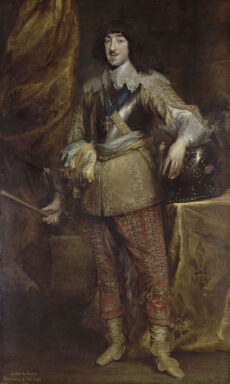
Portrait of Gaston of France, Duke of Orleans
Anton Van Dyck
1628-1634
The Tribune
Portrait of Gaston of France, Duke of Orleans - 1628-1634
Artist : Anton Van Dyck
The great Flemish artist, a court portrait painter in England, here offers a splendid effigy of Louis XIII’s brother, son of Henri IV and Marie de Medici. The prince, dressed in military apparel, is wearing the blue ribbon of the Order of the Holy Spirit. He is holding the baton of command in his right hand and his left elbow is resting on a lavishly decorated helmet. At the time, Gaston, who was first in line for succession to the throne, was constantly defying his brother the King and had to flee to Brussels in 1632. This is perhaps when the painter, in Brussels at that time, was called upon to paint this portrait. The date on the painting is indeed a subject of debate, and the actual date of painting is still discussed to this day. Van Dyck renders Gaston’s costume with breath-taking technique, bathing it in an opulent atmosphere of warm, golden shades. He renders the different textures of the fabrics, metal and skin tones with a precision that makes him one of the greatest portrait artists of his time.
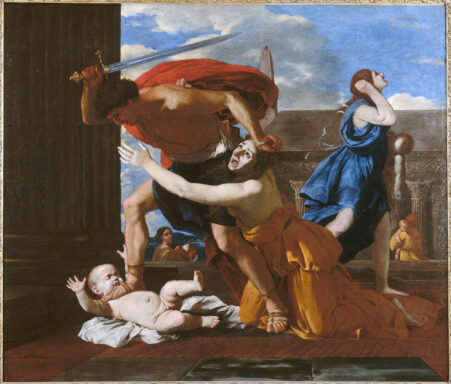
The Massacre of the Innocents
Nicolas Poussin
Circa 1628-1629
The Gallery of Painting
The Massacre of the Innocents - Circa 1628-1629
Artist : Nicolas Poussin
Commissioned from Nicolas Poussin (1594-1665) as part of the decoration for Vincenzo Giustiniani’s palace in Rome, this painting is inspired by an episode of the Gospel according to Saint Matthew. King Herod, informed by the Magi that the King of the Jews has just been born in Bethlehem, decides to have all boys aged two and under killed. Poussin minimizes the number of protagonists, which gives the work its dramatic strength. He also restricted his palette to three primary colours. Poussin structured its composition around two diagonals converging on the face of the screaming mother.

Portrait of Cardinal Richelieu
Philippe de Champaigne
1635-1636
The Gallery of Painting
Portrait of Cardinal Richelieu - 1635-1636
Artist : Philippe de Champaigne
Philippe de Champaigne first trained in Flanders before settling in Paris. He stopped there on the way to Rome, which he in fact never got to. In Paris he became close to Nicolas Poussin and was finally remarked by court and called upon by Marie de Medici. He painted portraits combining Flemish mastery and Parisian classicism. He moved towards Jansenism and as his career progressed he developed a more austere, sober style. In his portrait of Richelieu, he majestically depicts his protector, an enlightened patron he painted on many occasions. A group of portraits show him standing, almost in majesty, while in this portrait he appears rather serious, focused on his role as Minister.
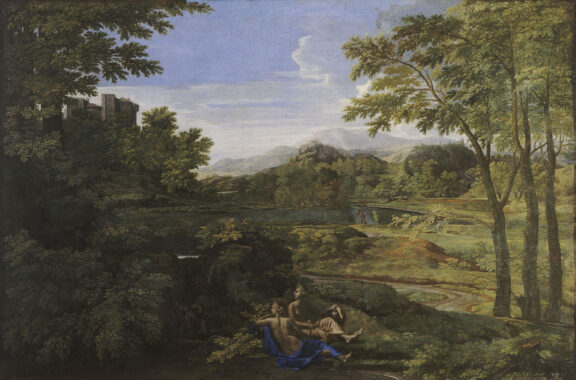
Landscapes with two nymphs and a snake
Nicolas Poussin
Late 1650s
The Gallery of Painting
Landscapes with two nymphs and a snake - Late 1650s
Artist : Nicolas Poussin
Here Poussin paints a typically Roman landscape, in the vein of the genre initiated in the early 17th century in Rome, particularly in Annibale Carracci’s entourage, but also thanks to the presence of Flemish artists who are increasingly numerous in the city. The landscape becomes almost autonomous in the composition, no longer serving as a simple setting for the subject. In this painting the French artist gives it imposing dimensions. Under the guise of a mythological subject justified by the presence of the characters, it is the landscape that dominates. The latter is highly constructed: although its aspect evokes the Lazio countryside, its layout owes little to reality. The mythological subject chosen by Poussin remains, as often, enigmatic: do the nymphs represent rivers where the snake would also have aquatic symbolism, or should they be interpreted as dichotomies? Although landscape painting was mainly a means to make a living on his arrival in Rome, he seems to have returned to it with particular enthusiasm at the end of his life, going beyond the early 17th century Roman model to give it a new dimension.
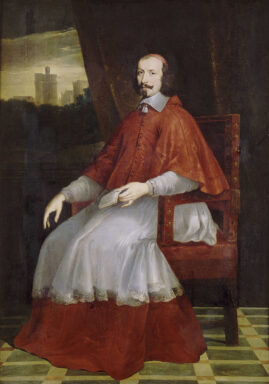
Portrait of Cardinal Jules Mazarin
Unknown
1652-1653
The Gallery of Painting
Portrait of Cardinal Jules Mazarin - 1652-1653
Artist : Unknown
Trained and protected by Richelieu, Mazarin succeeded him after his death in 1642. At the time he was a Minister of the Regent, Anne of Austria and of the young King Louis XIV, whom he served until his death in 1661. As in the portraits of Richelieu, we see the richly detailed moiré of the garments and the model is captured in the gravity and solemnity of his function, in a position similar to that of his predecessor. However, here Champaigne opens a window in the room onto a view of the Château de Vincennes. This detail makes it possible to establish the date of the painting: Mazarin became governor of Vincennes in 1652.
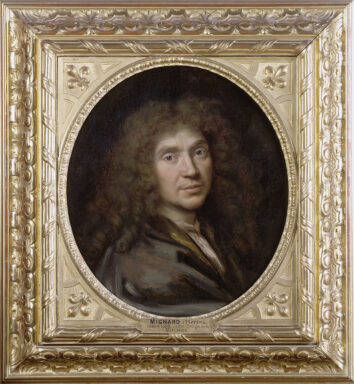
Portrait of Molière
Pierre Mignard
Circa 1658
The Tribune
Portrait of Molière - Circa 1658
Artist : Pierre Mignard
Pierre Mignard is one of the major classic French portrait artists. When he crossed paths with Molière in Avignon in 1658, after having worked in Orange and Saint-Rémy, a great friendship started between the two men, until the death of the writer in 1673. The painting in Chantilly probably dates from this meeting, because the model appears to be less than forty years old.
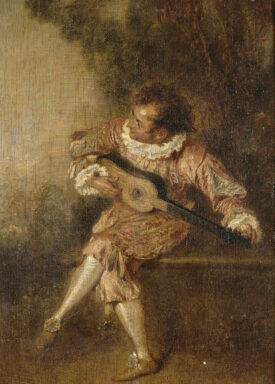
The Chord
Jean-Antoine Watteau
Circa 1715
The Caroline Room
The Chord - Circa 1715
Artist : Jean-Antoine Watteau
This painting has often been compared to that held by the Metropolitan Museum in New York, showing Mezzetino, a commedia dell’arte character, playing the guitar. It is true that musicians and actors have a prominent place in Watteau’s work. The delicate colours of this unclassifiable early 18th century artist’s refined painting inspire melancholy and the gentle pleasures of life.
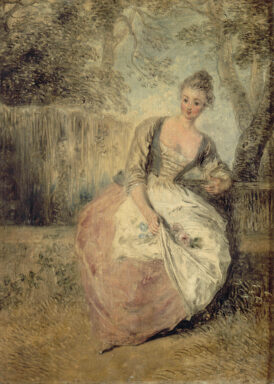
The Anxious Lover
Jean-Antoine Watteau
1715-1717
The Caroline Room
The Anxious Lover - 1715-1717
Artist : Jean-Antoine Watteau
At the start of the 18th century, Watteau (1684-1721) created a new type of painting called “fête galante”. His works frequently depict characters from the commedia dell’arte. He stages these at social gatherings in parks at nightfall, with young men courting young women in a rather melancholy atmosphere. The roses held by the young woman would thus be symbolic of a love that has already been consummated.
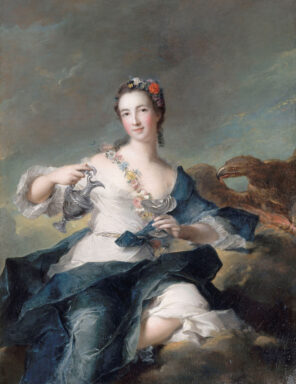
Portrait of Louise Henriette of Bourbon Conti, Duchess of Orleans, as Hebe
Jean-Marc Nattier
1732
The Minerva Rotunda
Portrait of Louise Henriette of Bourbon Conti, Duchess of Orleans, as Hebe - 1732
Artist : Jean-Marc Nattier
Goddess of eternal youth in the Greco-Roman pantheon, Hebe was in charge of serving the ambrosia of eternal life to the Gods. It was very fashionable in the 18th century to have one’s portrait painted after a Goddess, as is the case here with the Duchess of Orleans. Sitting on a cloud evoking Olympus, wearing an antique-style dress, radiantly beautiful, she is serving Zeus, symbolised by the eagle. The Condé Museum also holds a portrait of the Dauphine Marie-Antoinette, also depicted as Hebe.
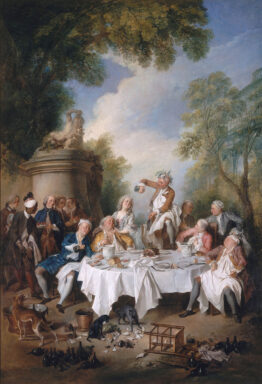
The Ham Dinner
Nicolas de Lancret
1735
The Gallery of Painting
The Ham Dinner - 1735
Artist : Nicolas de Lancret
Known as a fête galante painter, a genre innovated by Watteau, Nicolas Lancret received this royal commission from Louis XV. It is a pendant to Jean-François de Troy’s The Oyster Dinner, and was painted for the dining room in the small suites, decorated for the King in Versailles. There is no fête galante in this painting, but a depiction of a meal after hunting, Louis XV’s great passion, in which Lancret specialised. Under the auspices of a satyr, the guests are enjoying a ham, accompanied by wine they have undoubtedly abundantly consumed given the empty bottles, broken plates and flushed faces. The delicate, rustic atmosphere created by the mossy green of the trees and the trellis kiosk, is troubled by the bold colours and the mocking attitudes of the guests. The Duke of Aumale acquired this painting and its pendant in 1857. They had belonged to his father, King Louis-Philippe, and had great sentimental value for the Duke.
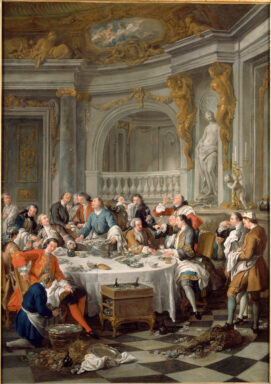
The Oyster Lunch
Jean-François de Troy
1735
The Gallery of Painting
The Oyster Lunch - 1735
Artist : Jean-François de Troy
This painting by Jean-François de Troy (1679- 1752) was commissioned in 1735 by King Louis XV for the “Petits Appartements” in the Château de Versailles, known as the “after the hunt” rooms, hence the absence of women. This is where he invited his friends to lunch after fox hunting. The gentlemen are eating oysters, which were very fashionable in the 18th century, on solid silver tableware, and drinking champagne. The servants and guests have their eyes on the cork, which is visible in the middle of the left column.

Young girl
Jean-Baptiste Greuze
Circa 1765
The Caroline Room
Young girl - Circa 1765
Artist : Jean-Baptiste Greuze
This study of the upper half of a young girl, is said to be a portrait of Georgette, the daughter of Greuze’s doorman, who served as a model for the fiancée’s young sister in L’accordée de village at the 1761 Salon, a painting (Paris, Louvre Museum) which greatly contributed to Greuze’s fame. According to other historians, rather than a study for the famous painting in the Louvre, it is an isolated copy dating from around 1765.
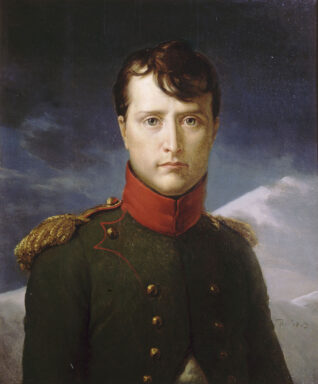
Napoleon Bonaparte, First consul
François Gérard
1803
The Tribune
Napoleon Bonaparte, First consul - 1803
Artist : François Gérard
A pupil of David and a historical painter at first, Gérard followed his Master’s footsteps and became portrait artist to the Emperor and his court. Here, one year before Napoleon’s coronation, he painted a portrait of the young general, appointed First consul of the Republic, with all the codes that would be used in portraits featuring ceremonial costume. The hieratic pose, in full-face view, and wisps of dishevelled hair translate the spirit of the Napoleonic epic that had already begun, just as they magnify the conquering figure, perhaps in reference to Alexander the Great. The gleaming, almost feverish, gaze heightens this impression. But as in all portraits, the features seem idealised, because the Emperor was not posing and, as a shrewd politician, he wanted his image to further convey the myth of his character rather than a true likeness.
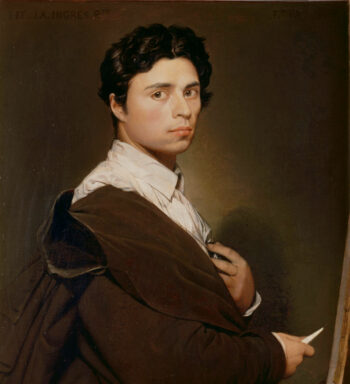
Self-Portrait at the Age of Twenty-Four
Ingres
1804
The Tribune
Self-Portrait at the Age of Twenty-Four - 1804
Artist : Ingres
Ingres (1780-1867) started this self-portrait at the age of twenty-four, at the very start of his career. The panting was very different then to what it is today: the costume featured numerous details and the artist was depicted painting a portrait of his friend Gilibert. Poorly received by the critics in 1806, lngres left it aside, came back to it on several occasions and finished it when he was seventy-one years old. Ingres refined his portrait, removing superfluous details. The palette is reduced to a few warm tones that highlight the face contrasting with the white shirt. This composition is one of the finest portraits by the artist.
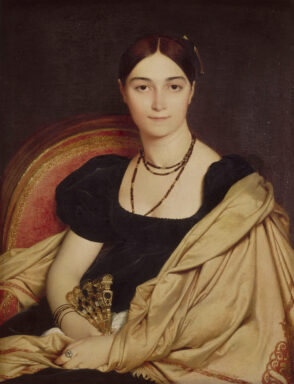
Portrait of Madame Duvaucey
Ingres
1807
The Tribune
Portrait of Madame Duvaucey - 1807
Artist : Ingres
Madame Duvaucey was the mistress of Baron Alquier, the French Ambassador in Rome. She was painted by Ingres in 1807, during a stay in Rome. This painting is nicknamed the “Mona Lisa” of Ingres (1780-1867). It is the first and one of the most beautiful female portraits by the artist, and is full of curves. Madame Duvaucey was penniless at the end of her life and brought the portrait back to Ingres, who bought it from her.

Antiochus and Stratonice
Jean Auguste Dominique Ingres
1840
The Tribune
Antiochus and Stratonice - 1840
Artist : Jean Auguste Dominique Ingres
The subject is taken from Plutarch’s Lives of illustrious Men: Stratonice marries Seleucus I Nicator, King of Syria, but Antiochus, her husband’s son from a first marriage, falls so deeply in love with her that he falls seriously ill. The scene depicts the moment when the doctor Erasistratus understands the cause of his illness: Antiochus’s heartbeat quickens at the sight of Stratonice. The doctor has the old king believe that Antiochus is in love with his own wife; Seleucus begs him to leave her, then, having learnt the truth, offers his wife to his son in order to save him.
Ingres, who was a musician, knew the opera Stratonice, created in 1792 in Paris, the music for which was composed by Méhul (1763-1817).
Ingres, who had travelled in 1834 to the Villa Medici as Director of the French Academy, painted this work in Rome. It took him seven years to finish the painting, making numerous drawings and taking inspiration from antique statues for the figure of Stratonice. He covered this subject seven times in sixty-five years.
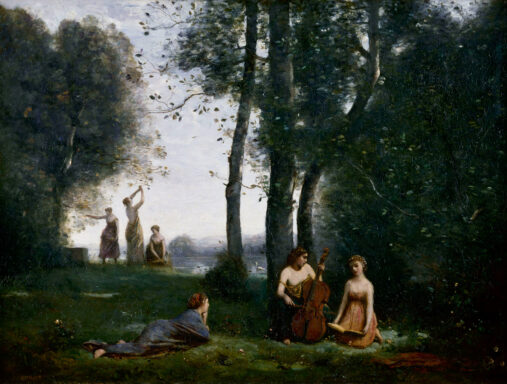
Woodland Music Makers
Jean-Baptiste-Camille Corot
1844-1857
The Gallery of Painting
Woodland Music Makers - 1844-1857
Artist : Jean-Baptiste-Camille Corot
On the banks of a pond, a woman is playing the cello. One of her companions is singing beside her while the other is lying on the grass listening to them. The faces of these young women are barely outlined, as if it were the music itself that the painter wished to depict. This painting is one of the last acquired by the Duke of Aumale, who said he liked paintings to tell him a story.
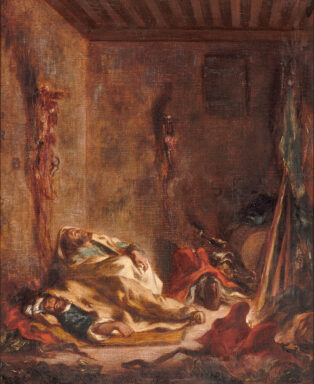
The Guardhouse in Meknès
Eugène Delacroix
1847
The Isabelle Room
The Guardhouse in Meknès - 1847
Artist : Eugène Delacroix
This painting by Eugène Delacroix is part of the Orientalist movement. The painter experienced the shock of discovering the Orient when, from January to June 1832, he accompanied a French embassy that was travelling to Morocco with Sultan Mulay Abd er-Rhaman.
His trip to Meknès took place between mid-March and early April 1832, before returning to Tangiers. He painted this composition based on his notebooks and his memories, almost fifteen years after the event. The trip to Morocco was a key moment when the leader of the Romantic school turned towards Orientalism, struck by the light, colour and picturesqueness of North Africa.
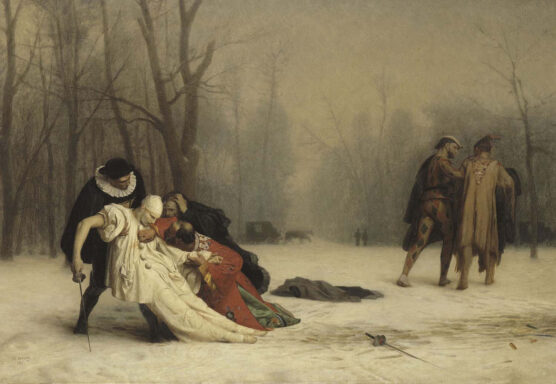
The Duel after the Masquerade
Jean Léon Gérôme
1857
The Isabelle Room
The Duel after the Masquerade - 1857
Artist : Jean Léon Gérôme
This painting depicts the tragic aftermath of a masquerade, the result of a duel where the guest disguised as Pierrot collapses in the arms of his witnesses while his adversary, disguised as an Amerindian, having dropped some feathers on the snow, leaves the scene, accompanied by a Harlequin. A scene with almost identical characters was depicted in the same year by Thomas Couture, in a painting held in London (Wallace Collection). Both historical painters were practising genre painting, which in this case borders on sensationalism: several duels that took place in the Bois de Boulogne following masquerades had made the headlines at that time. Are the commedia dell’arte characters authentic or do they highlight the absurdity of the tragedy? The Duke of Aumale, who was close to Gérôme, acquired the painting after his exhibitions at the 1857 Salon in Paris, and then in London.

Hunting heron, Algeria
Eugène Fromentin
1865
The Gallery of Painting
Hunting heron, Algeria - 1865
Artist : Eugène Fromentin
A painter and author, Fromentin was influenced by several trips to Algeria between 1846 and 1853. He wanted to give his work a more scientific dimension, as he planned to draw travel narratives and engravings from it. The painting shows a group hunting for heron with falcons, a practice reserved for the elite. 19th century Orientalism was more inclined to depict the colours and sensuality of an imagined exoticism. Yet here, Fromentin focuses on the immensity of the landscape, rendered by the distance between the riders, and on an overwhelming, cloudy sky that seems to project the light onto the water and blind the spectator. He seems to want to render the Orient he explored and found fascinating in an almost documentary, but nonetheless poetic, manner.
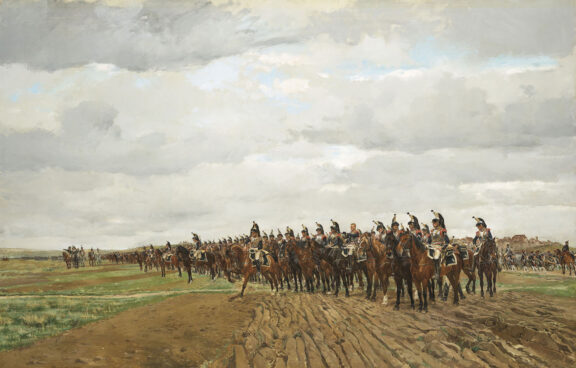
1805, Cuirassiers before the Charge
Jean Louis Ernest Meissonier
1878
The Gallery of Painting
1805, Cuirassiers before the Charge - 1878
Artist : Jean Louis Ernest Meissonier
In his ambitious paintings, Meissonier wanted to recount the great Napoleonic epic that was still inspiring the artists of the 19th century. He was already a recognised artist, whose paintings were being snapped up and hugely popular in collections when he finished this painting, which was presented at the 1878 World Exhibition. Although it depicts Napoleonic combats, this composition does not place the Emperor to the fore. He can just be made out in the distance, wearing his bicorn hat, with his arm stretched out towards the theatre of operations. The officers advance and the cavalry are in rank behind them. Set in a dull, overcast landscape, where the furrowed earth vies with the low sky, Meissonnier seems to have wanted to depict the energy and excitement before the battle. This is probably what appealed to the Duke of Aumale, who acquired this painting on his return from exile in 1889, for a substantial price.

